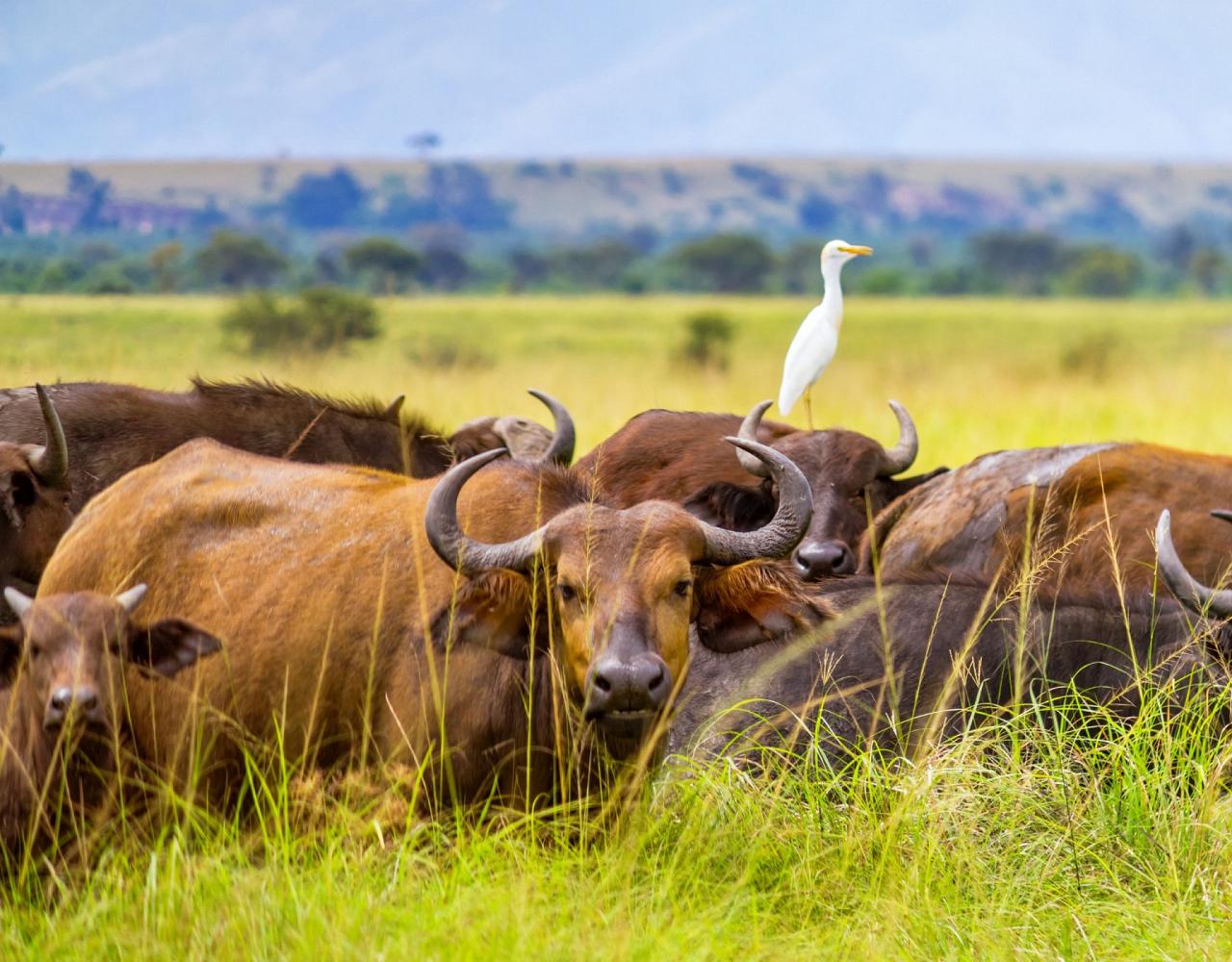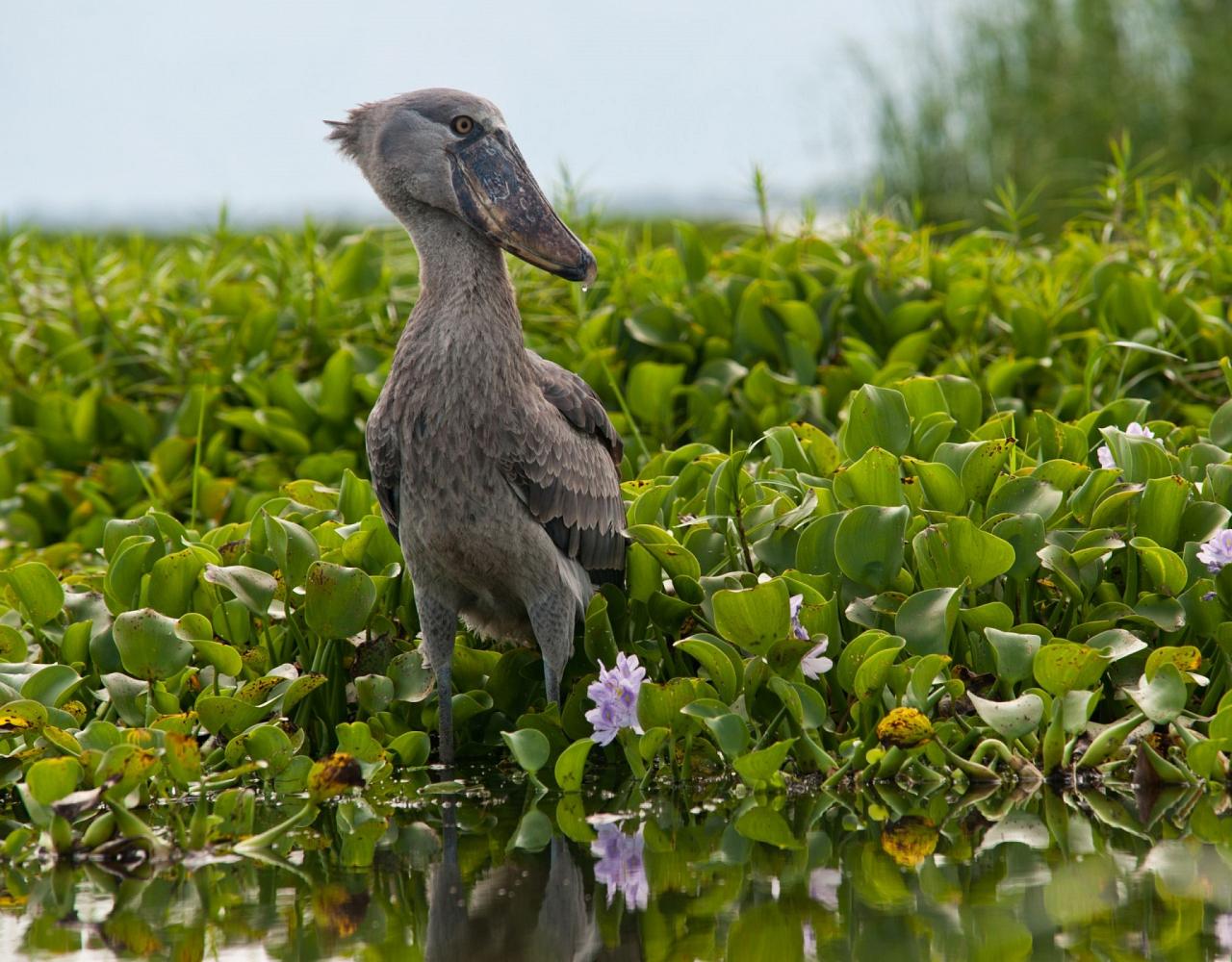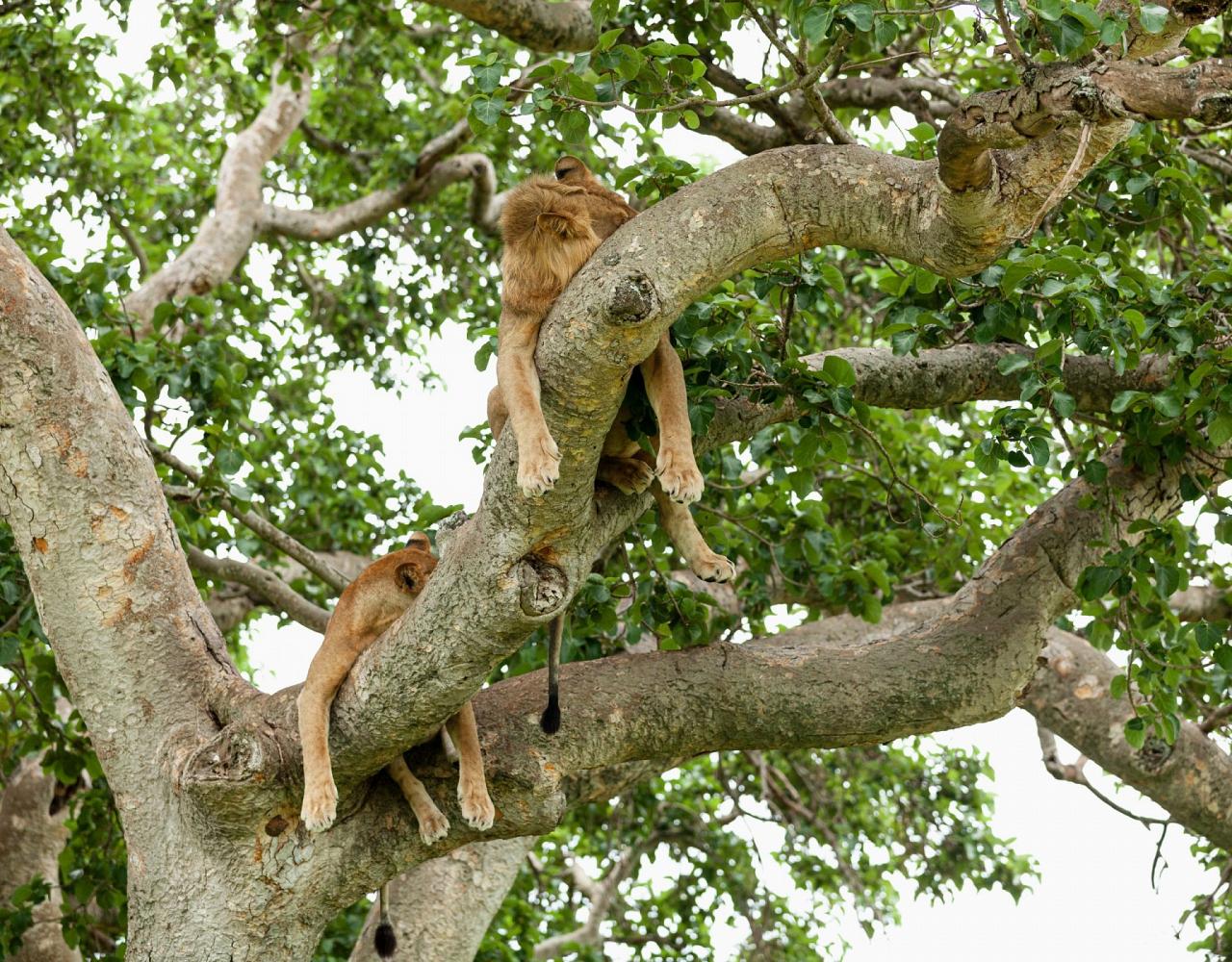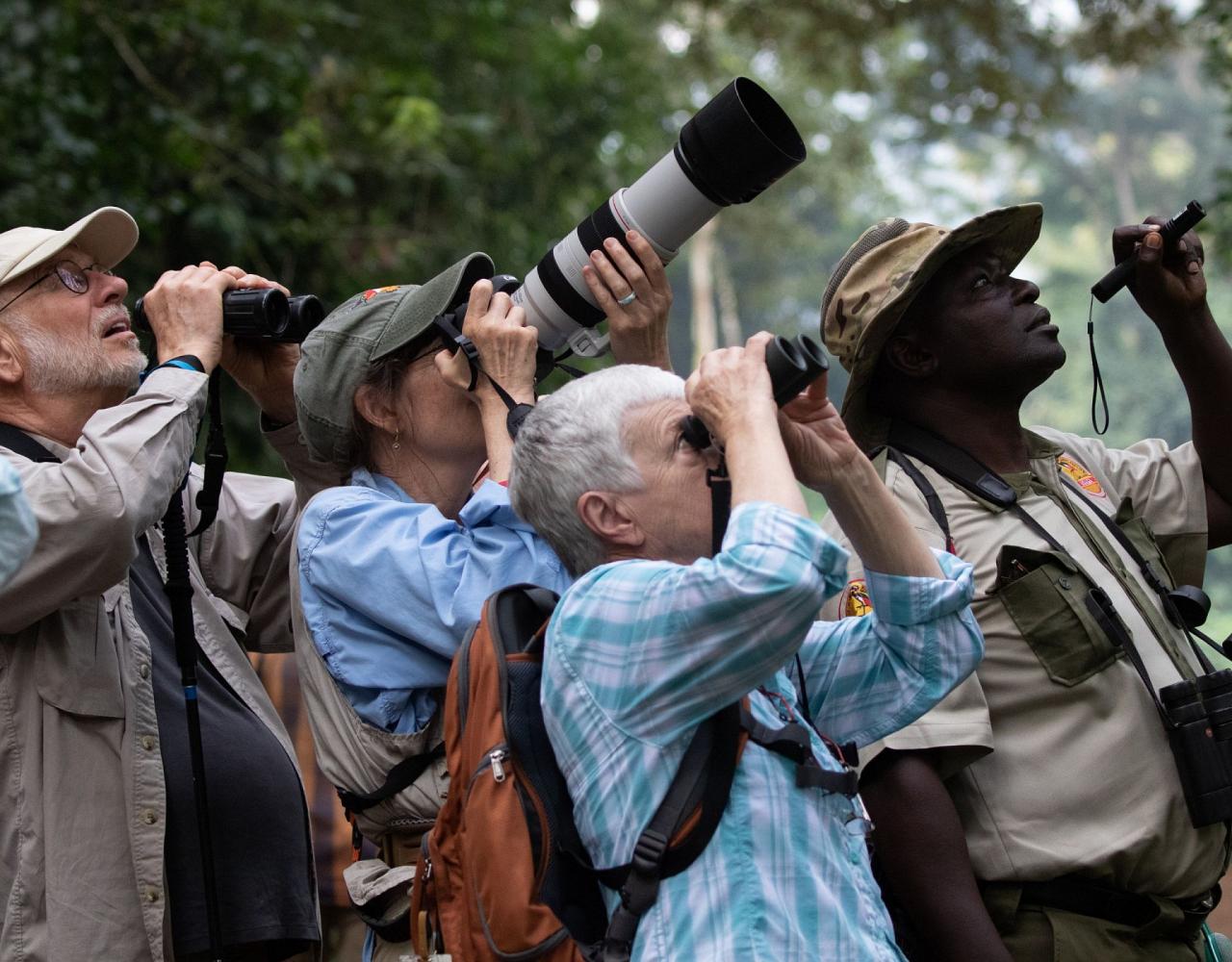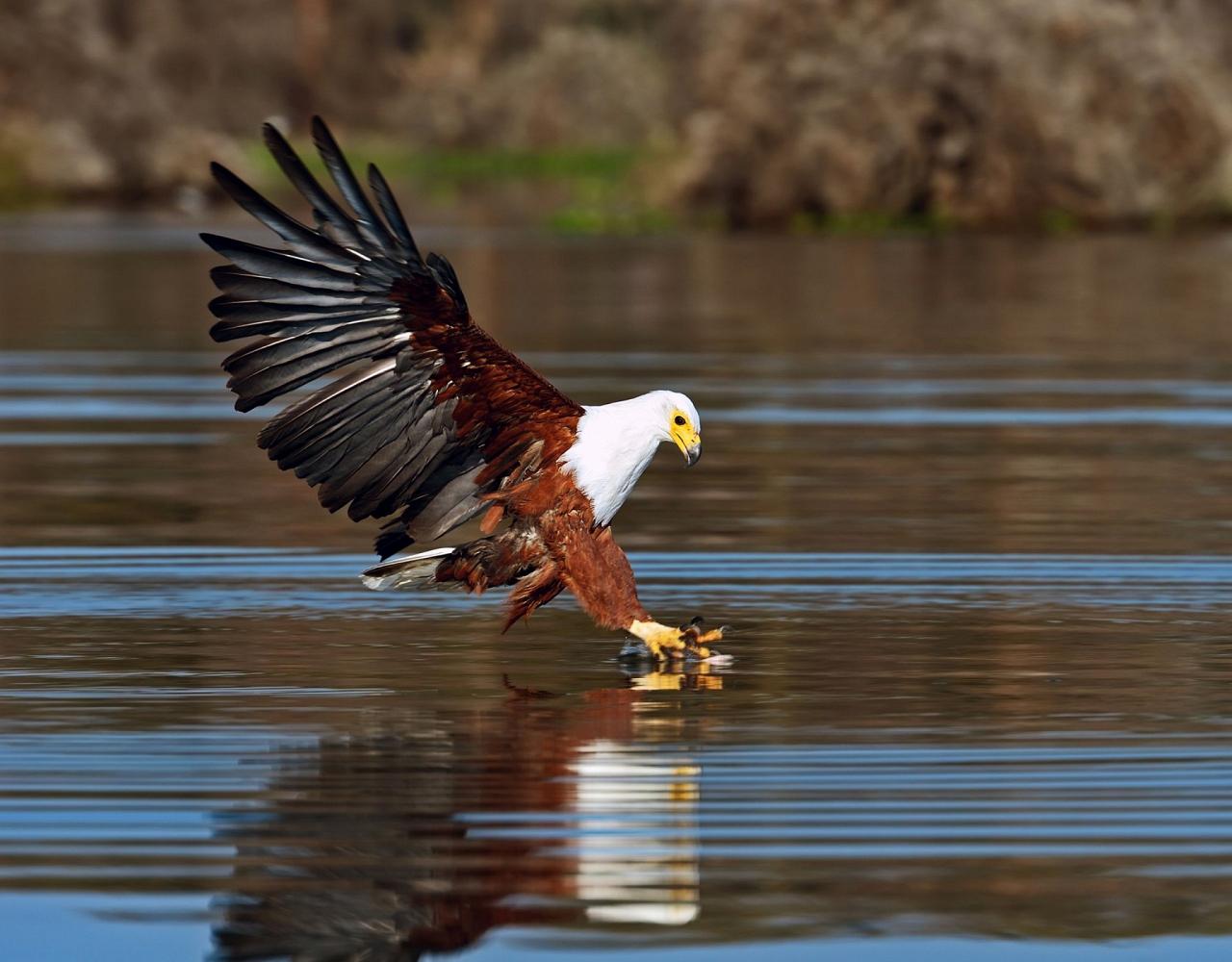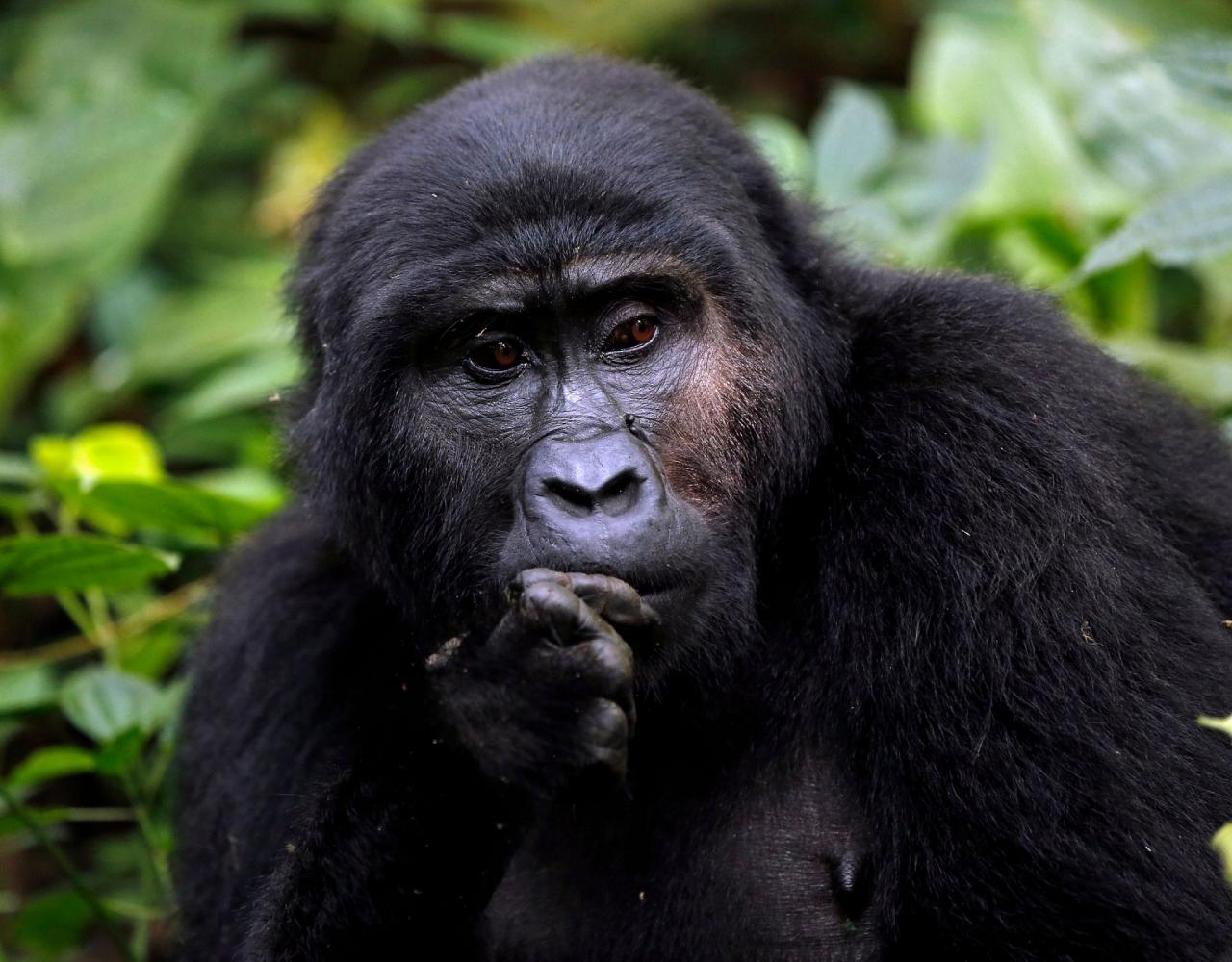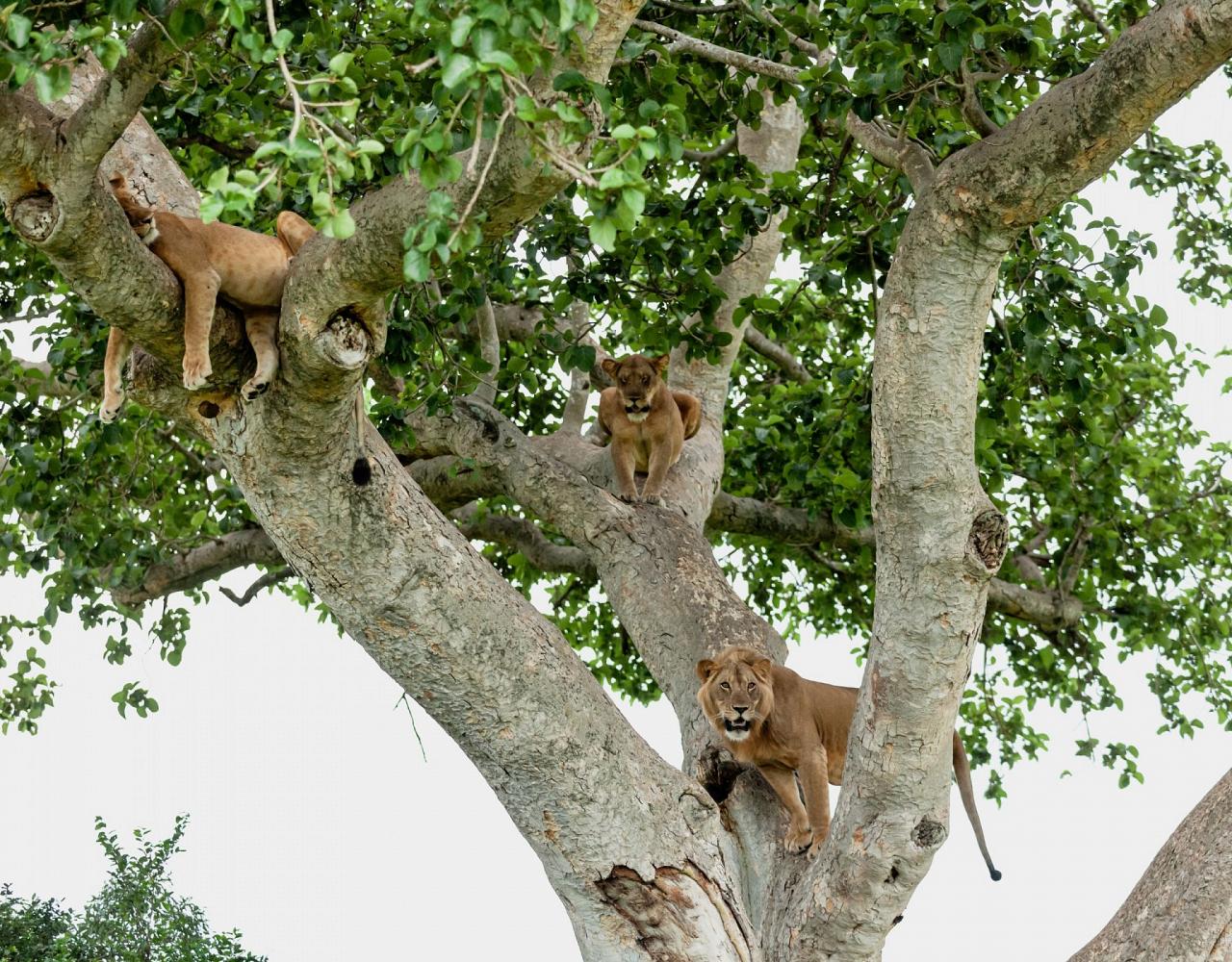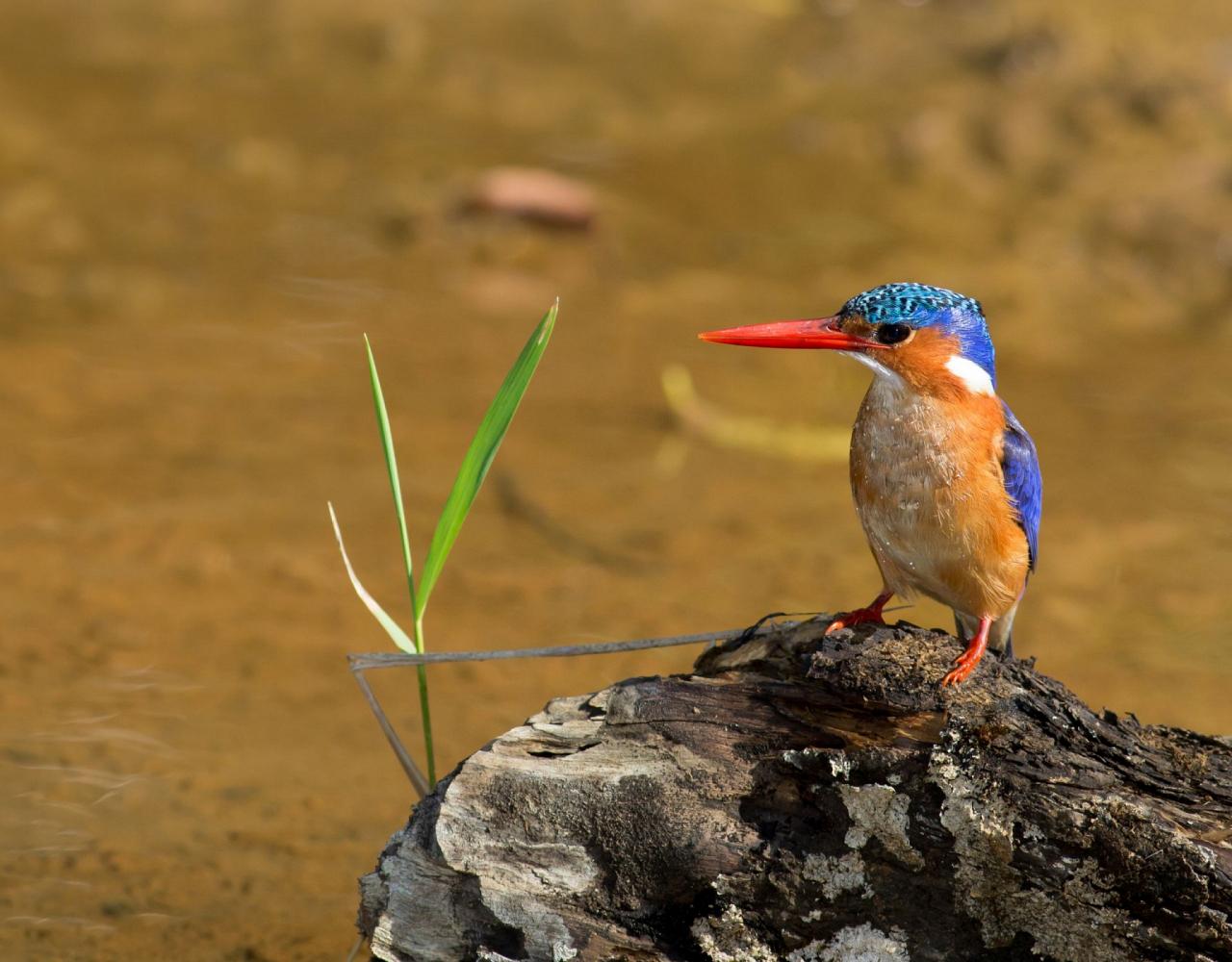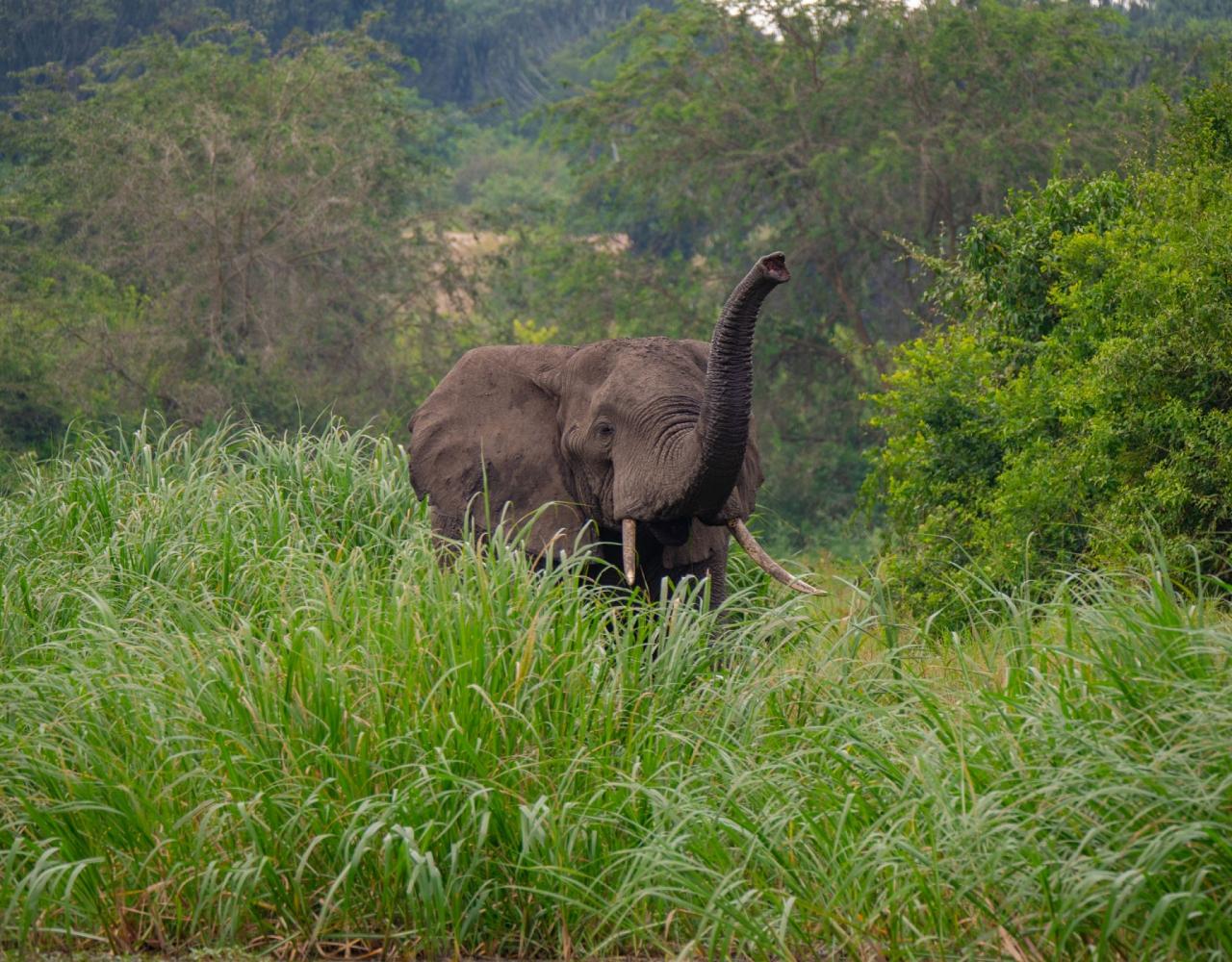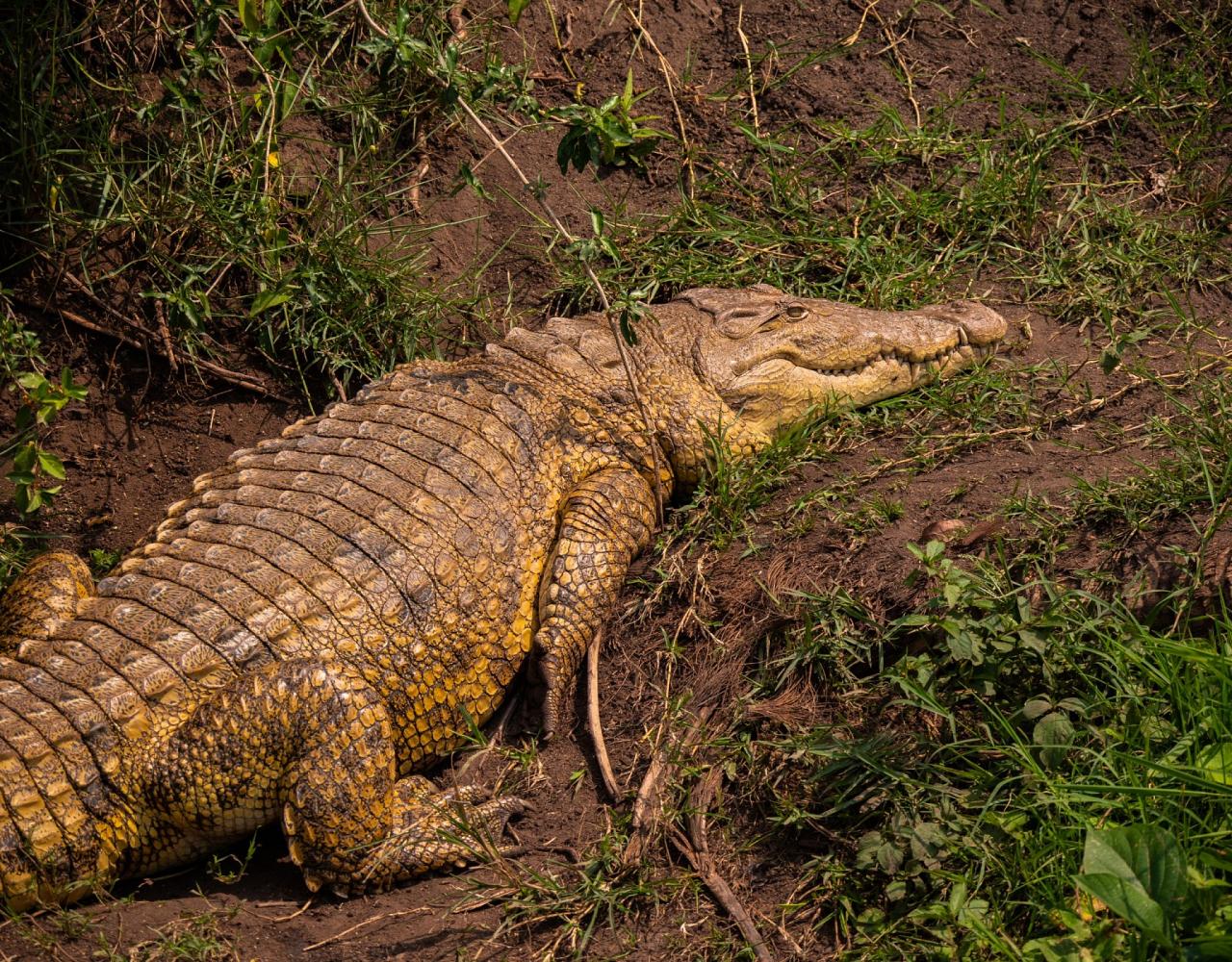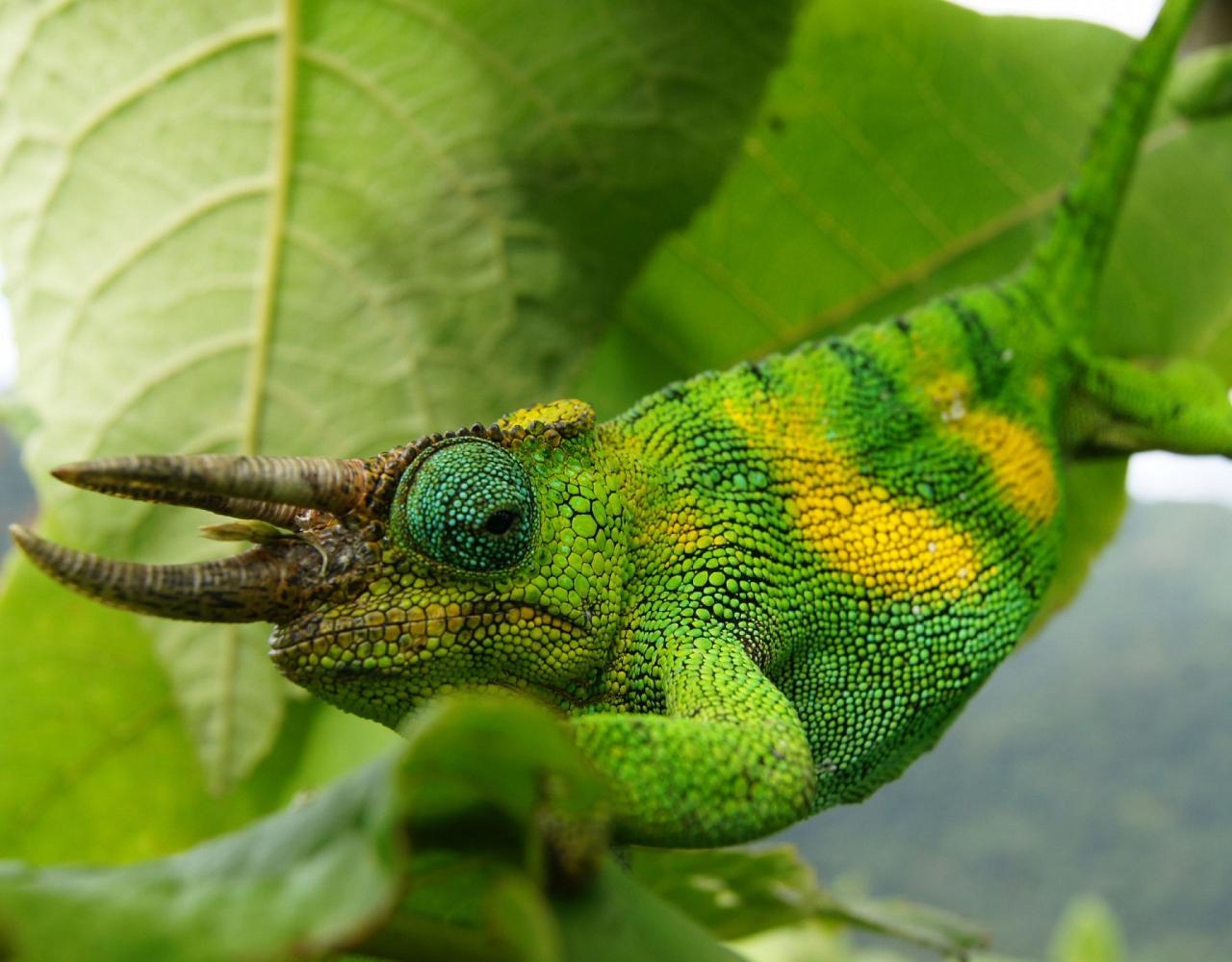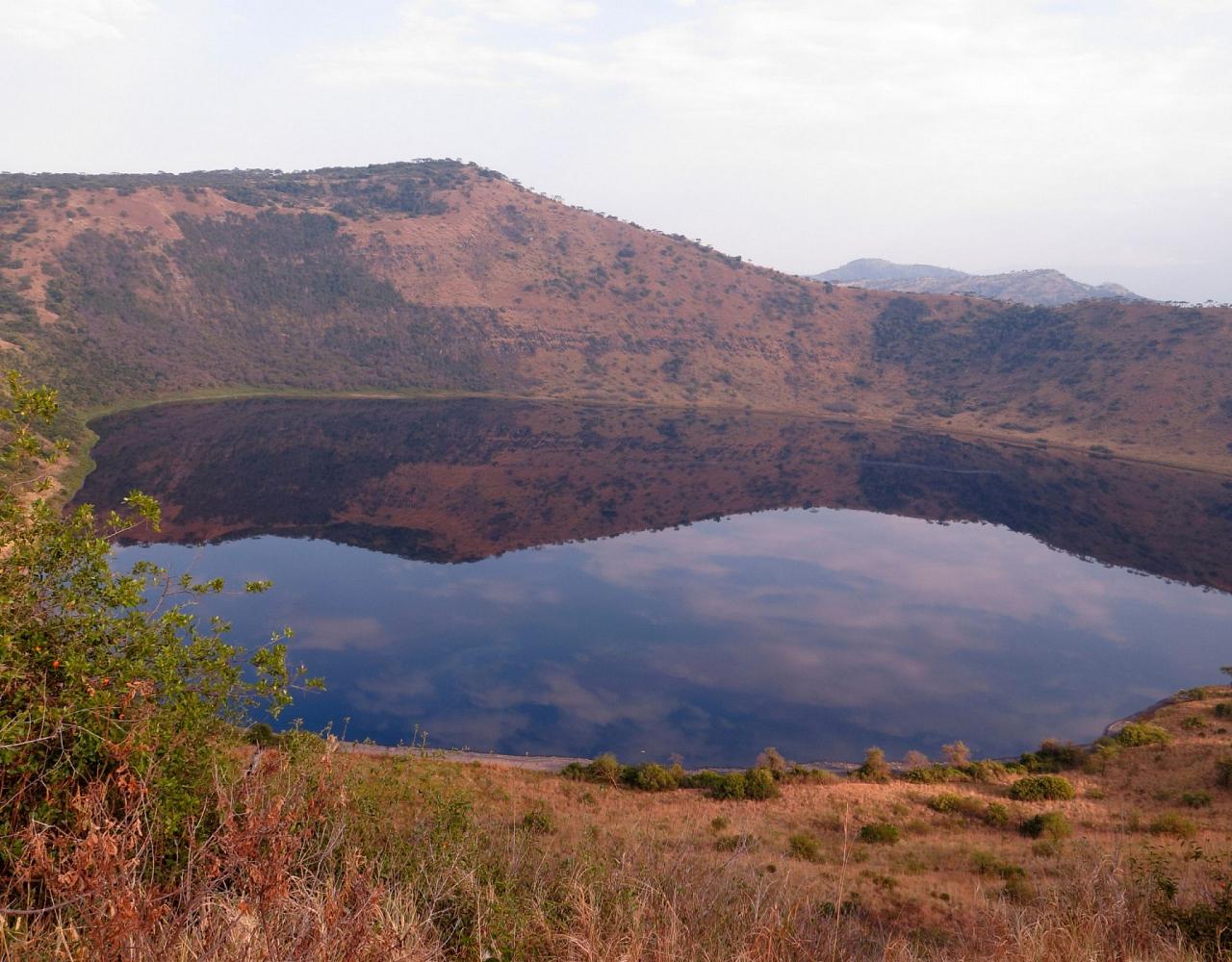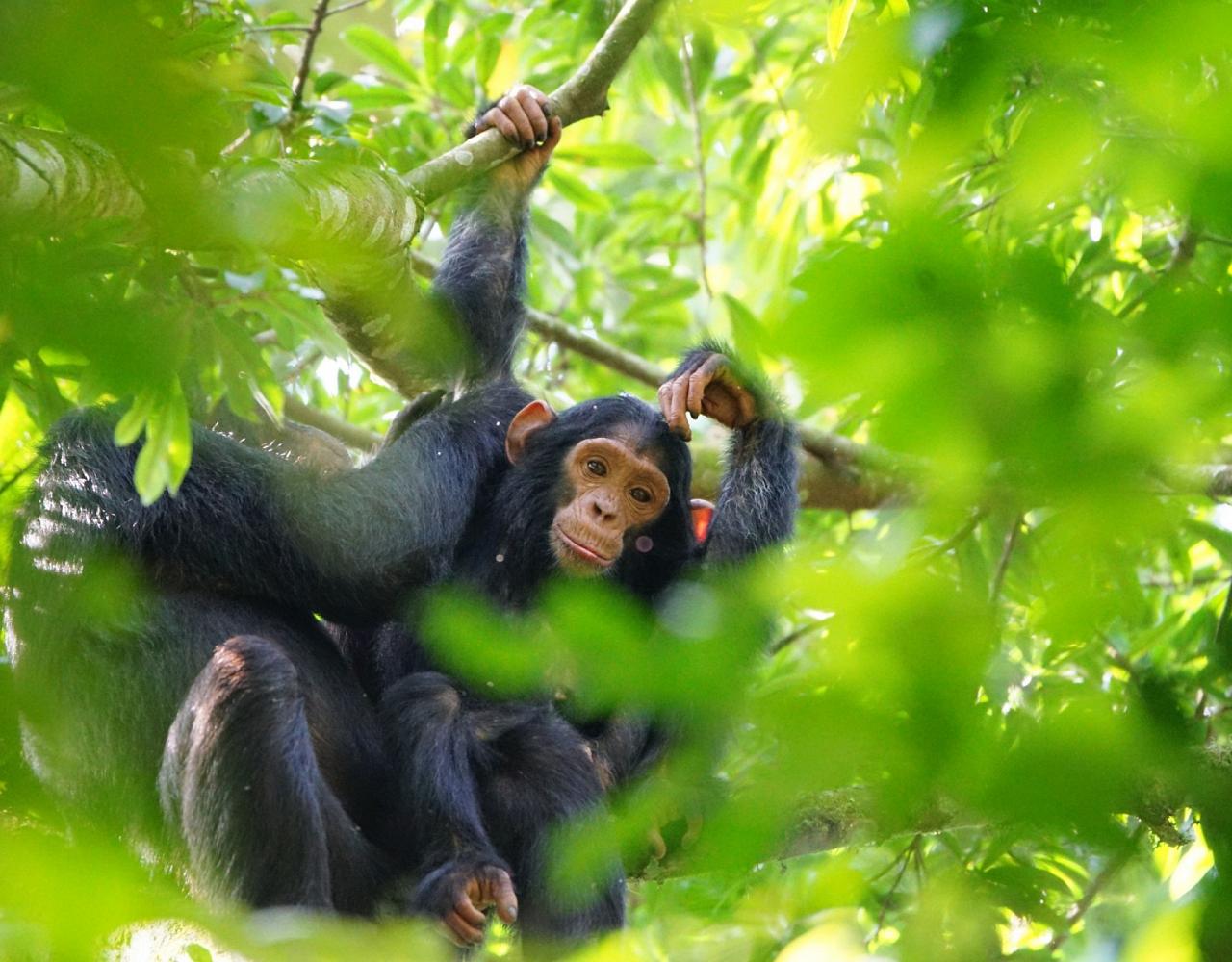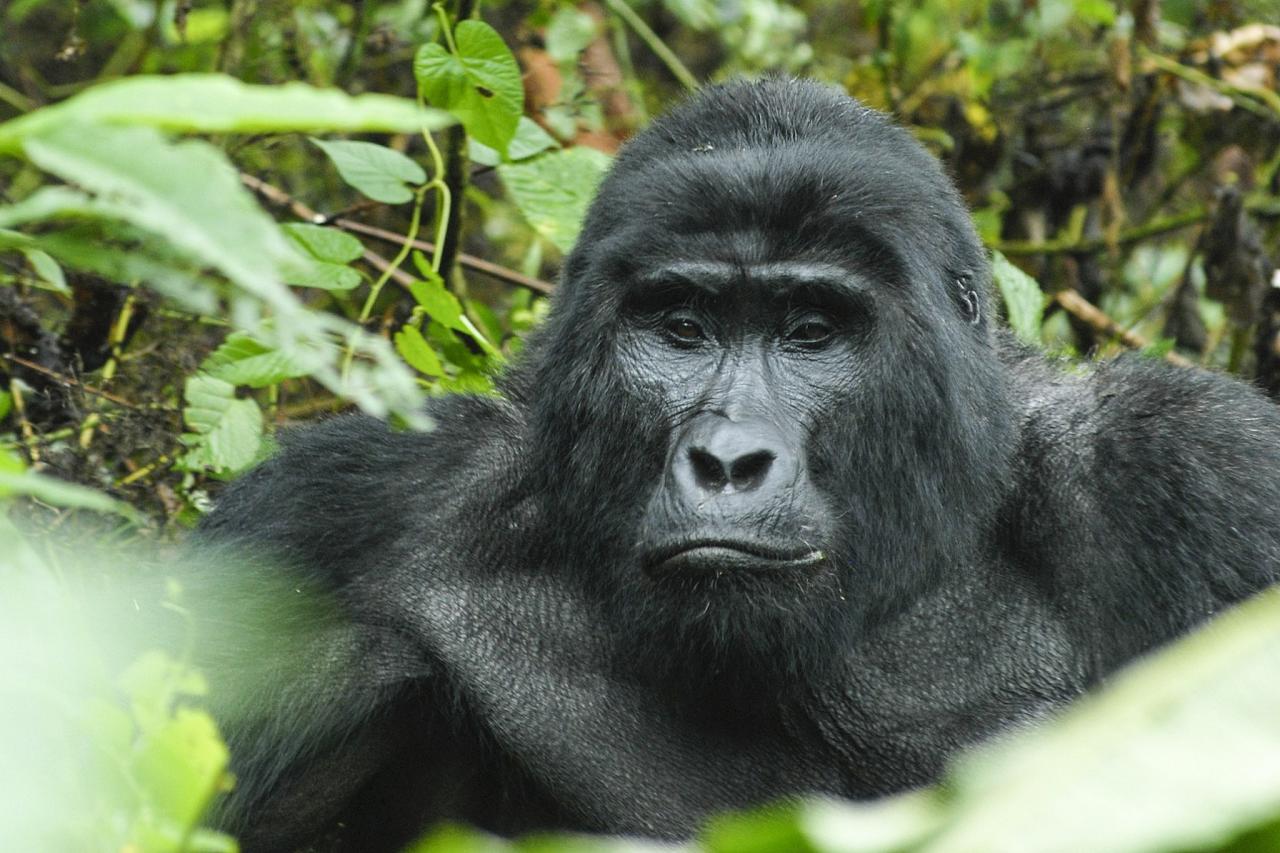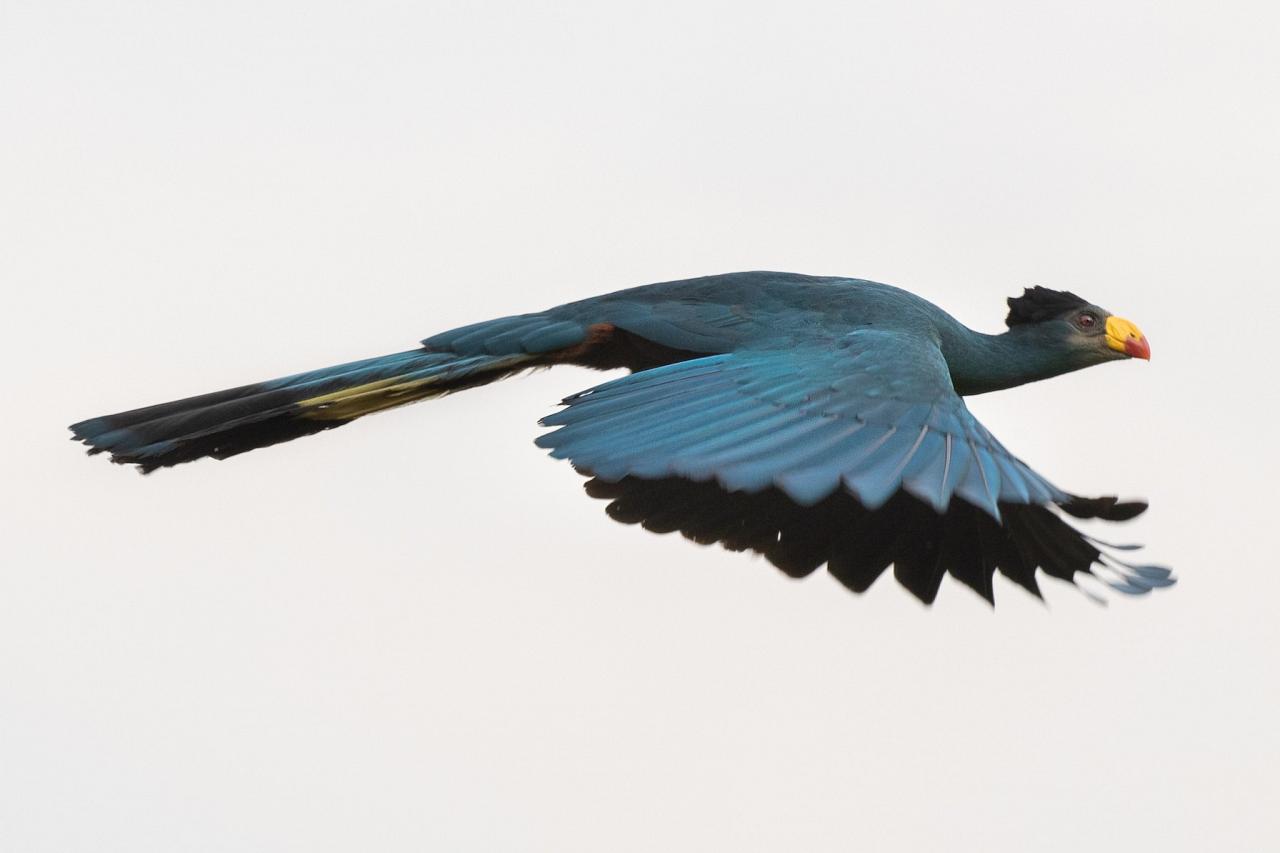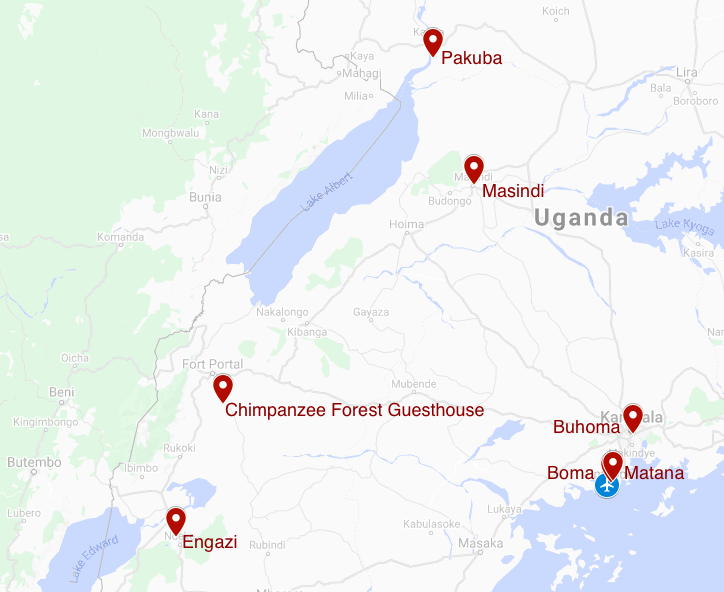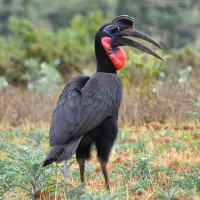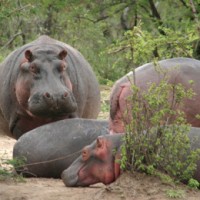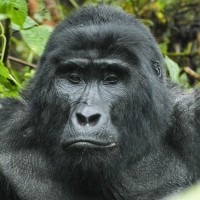Trip Itinerary
Itineraries are guidelines; variations in itinerary may occur to account for weather, road conditions, closures, etc. and to maximize your experience.
Sat., July 13:
Arrive in Entebbe, on the Shore of Lake Victoria
Several major airlines provide service to Entebbe, including United, Delta, Emirates, Ethiopian, KLM, and others. Typical stops en route include your gateway through Brussels, Amsterdam, Nairobi, Addis Ababa, Doha, or Kigali. Note, you need to leave the day prior to arrival, July 12 departing the USA. If you wish to combine with another part of Africa, then Kenya or Ethiopia work well and in both we have partner companies that can provide guided custom excursions.
Today is planned as just a day of rest; for those arriving in time we gather for a welcome dinner at our hotel. For those that arrive early in the day, you can rest and enjoy birding on the grounds. The hotel is close to the airport, and provides dependable and convenient shuttle service.
For those who come in early, you have the option to join a guided botanic garden tour today.
Accommodations at the Boma Hotel, Entebbe (D)
Sun., July 14:
Mabamba Wetlands | Botanic Gardens
After an early breakfast, we proceed to the Mabamba Swamp, a Wetland of International Importance, in search of water birds including Uganda’s iconic Shoebill. In this narrow bay, lined by papyrus, other specialty birds include Hamerkop, Lesser Jacana, Blue Swallow, Papyrus Gonolek, White-winged Warbler, Blue-breasted and Madagascar Bee-eaters, Gray-rumped Swallow, Greater Swamp-Warbler, Slender-billed Weaver, African Pygmy-Kingfisher, and Plain-backed Pipit. Waterbirds include African Pygmy-Goose, Spur-winged Goose, Long-toed Lapwing, Gray-hooded Gull, and three species of terns: Gull-billed, White-winged Black, and Whiskered. We may be lucky and find the giant of all herons, the Goliath. Raptors include the interesting Lizard Buzzard, and perhaps the Palm-nut Vulture. Mammal fans want to be on the lookout for Spot-necked Otter, occasionally seen in the water here.
Mabamba Swamp is a labyrinth of channels and lagoons. Even getting there holds exciting birding! The road to Mabamba winds its way through areas of secondary forest and agricultural land, attracting Red-headed Lovebird, African Crowned-Hornbill, and a range of sunbirds including the Green-headed, Green, Red-chested, Collared, Marico, and Scarlet-chested. The road ultimately ends at a papyrus reed-bed adjoining Lake Victoria, whereby canoe we explore a maze of channels and mudflats for a reliable resident, the majestic Shoebill.
This afternoon we explore the local botanic gardens with our guide. Trails are well-manicured and easy for walking and birding.
Accommodations at the Boma, Entebbe (D)
Mon., Jul. 15:
Lake Mburo National Park
If we dipped on the Shoebill yesterday, we head back to Mabamba Wetlands this morning before we drive to Lake Mburo. If we were successful, we depart directly for Lake Mburo National Park.
While small, this park has outstanding biodiversity, with numerous species of birds and an excellent array of large mammals including Burchell’s Zebra, Impala, Elands, Topi, and Buffalo. Oribi can be found here, as well as Olive Baboon, and Waterbuck and Reedbuck that relish the lush habitat. Where grazing mammals occur, we find Yellow-billed Oxpecker as well.
The park contains an extensive area of wetland including lakes and marshes. Ancient Precambrian rock tells a fascinating geologic story. The bird population is rich, including Green-backed Woodpecker, African Finfoot, Brown-chested Plover, Southern Ground Hornbill, Spot-flanked, Red-faced and Black-collared Barbets, White–winged Warbler, Carruthers Cisticola, Papyrus Gonolek, Yellow-billed Oxpecker, and Northern Brown-throated Weaver. Gray-crowned Crane are often the photographers’ favorite.
After a full and rewarding day, we enjoy dinner and our comfortable lodgings. And keep on the lookout for nightjars!
Accommodations at the Mantana Tented Camp, Lake Mburo (B,L,D)

Tues., Jul. 16:
Mburo National Park: Full Day Birding, Game Drive & Boat Cruise
We leave Entebbe on We have the full day to explore the park today. With our expert guides, we look for birds and mammals. Search the skies for Tawny Eagle, Ruppel's Griffon Vulture, Grey Kestrel, and the differently patterned male and female Bateleur. Feeding in trees we look for Ruppel's Starling, Brown Parrot, Grey Hornbill, White-browed Coucal, Northern Brubru, Black-headed Oriole; in and around their roots we may find Water Thick-knee seeking shade or Coqui Francolin busily feeding. Favorites for the day often include Shining Blue, Woodland, and Giant Kingfishers, Broad-billed Roller, and Little Bee-eater. With keen eyes we may spot a roosting Verreaux's Eagle Owl, a Greater Honeyguide, and associated with water, White-backed Night-Heron, Papyrus Gonolek, Lesser Masked Weaver, and Carruther’s Cisiticola.
In more open savanna, dotted with acacias, we look for Senegal Lapwing and birds of the grasslands and scrub, including White-backed Scrub Robin, Plain-backed Pipit, Sooty Chat, Tawny-flanked Prinia, Red-faced Crombec, Chinspot Batis, Grassland Pipit, and Golden-breasted Bunting. Learn to sort out starlings today: Rupell’s Long-tailed, Greater Blue-eared, and Bronze-tailed.
We return to our upmarket tented camp for an enjoyable evening. Chefs take pride in our meals, and include fresh local foods in the menu. Enjoy drinks from the bar, and as night falls, sounds of the African night.
Accommodations at the Mantana Tented Camp, Lake Mburo (B,L,D)
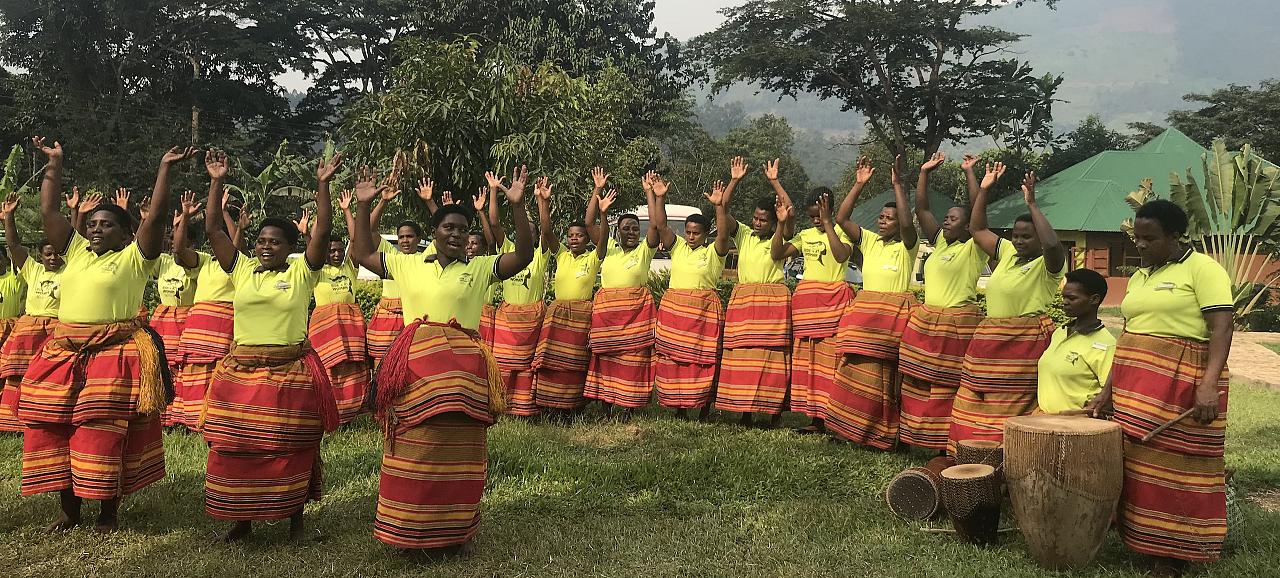
Wed., Jul. 17:
Drive to Bwindi Impenetrable Forest National Park
Today we start early after breakfast, with an exciting destination in mind—the Bwindi Impenetrable Forest. This is mainly a travel day, our drive time is 6 – 7 hours or more, depending on the stops we make for scenery and birding (and lunch) along the way.
Bwindi National Park is a UNESCO World Heritage Site and is home to approximately half of the world’s endangered population of Mountain Gorillas. This vast reserve offers arguably the most productive montane forest birding in Africa and supports 23 of Uganda's 24 Albertine Rift endemic bird species.
Once part of a much larger forest that included the Virunga Volcanoes in neighboring Rwanda, Bwindi Impenetrable National Park is now an ecological island within a sea of human cultivation and therefore of big conservation importance. We have several days here to enjoy the world-famous Mountain Gorillas (permit required, additional cost) and some spectacular birding.
Our lodge opened in 2014, with a mission to provide lodging for the park while supporting the local community. It is a small lodge, with wonderful hospitality.
Accommodations near Bwindi (B,L,D)

Thurs., Jul. 18:
Gorilla Tracking in the Forest
For those that select the Gorilla tracking option, after an early breakfast, we report to the park headquarters for a briefing prior to the Gorilla tracking excursion. This activity may take anywhere from one hour to a full day, so a reasonable degree of fitness is required. The hike starts about 8:30 – 9:00 AM and we are back anytime of the day. It may be just an hour or several hours. It is a wonderful experience to stare into the eyes of these gentle giants; watch them in awe as they play and go about their daily activities. It is indeed a “once in a lifetime” experience. Each encounter is different and has its own rewards; we are likely to enjoy close view of adults feeding, grooming, and resting as the youngsters frolic and swing from vines in a delightfully playful display. Only a limited number of people are allowed in to see the family groups each day (we have two days and may split up between them), so the earlier you sign on the better. We forward your permit payment on with registration. The forest habitat is fascinating, with lush greenery and of course, a host of birds.
We hope that our whole groups opts for the gorilla trek; our visit supports their conservation and rangers work hard to pace the hike for you to have success in finding them. If you are not able to do the hike, or perhaps have seen them at another location, birding is plentiful and an alternate activity on this day. Also possible are short nature walks or a cultural visit.
Accommodations near Bwindi (B,L,D)
Fri., Jul. 19:
Birding Bwindi
Forest birding at Bwindi ranks the best birdwatching in Uganda and Africa as well, having been voted the number one hot spot in Africa. It is home to over 23 highly-localized Albertine Rift endemics. Our birding today takes place at different elevations, much of it in mid-montane forest.
The list of special birds is long! Sunbirds appear like our hummingbirds, but are songbirds that sing. We look for Blue-headed Sunbird, Northern Double-collared Sunbird, and Grey-headed Sunbird, Green-throated Sunbird, and Blue-throated Brown Sunbird. Stunning and colorful are the Black-billed Turaco, Bar-tailed Trogon, Cinnamon-chested Bee-eater, Lagden’s Bush-shrike, Doherty's Bush-shrike, Montane Oriole, African Golden Oriole, and the smaller Oriole Finch. Flycatchers and other small birds of the forest include Black-faced Rufous Warbler, Grauer's Warbler, Banded Prinia, three species of Apalis: Black-throated and Mountain Masked, Red-throated Alethe, Yellow-eyed Black-Flycatcher, Ashy Flycatcher, Dusky-blue Flycatcher, Chapin's Flycatcher, Chin-spot Batis, Rwenzori Batis, Black-and-white Shrike-flycatcher, White-bellied Crested-flycatcher, Mountain Illadopsis, and Dusky Tit.
Noisy are the African Hill-Babbler, Sooty Boubou, Pink-footed Puffback, and White-naped Raven. Starlings, various finches, sparrows, and weavers abound, including Stuhlmann's Starling, Narrow-tailed Starling, Waller's Starling, Strange Weaver, Brown-capped Weaver, Black-billed Weaver, Dusky Crimsonwing, Yellow-bellied Waxbill, Magpie Mannikin, Yellow-crowned Canary, Thick-billed Seedeater, Streaky Seedeater, and Shelly's Crimsonwing. Overhead, we look for two striking raptors, Mountain Buzzard and Ayre's Hawk-eagle.
Sought after as we work a mix of elevations are African Wood-Owl, Scarce Swift, Black Bee-eater, Red-chested Owlet, Tullberg's and Elliot's Woodpeckers, African Broadbill, Petit's Cuckoo-shrike, Grey Cuckoo-shrike, Archer's Ground Robin, Toro Olive-Greenbul, Ansorge's Greenbul, Equatorial Akalat, White-bellied Robin-chat, Olive Thrush, White-tailed Ant-Thrush, Short-tailed Warbler, and Red-faced Woodland-Warbler.
We could continue, but you can see from those species mentioned here that the area is rich! Extremely rare and likely tough to find, requiring more extensive hiking than we do, is the endemic African Green Broadbill.
We return to the hospitality of our lodge, to dine and enjoy the evening.
Accommodations near Bwindi (B,L,D)
Sat., Jul. 20:
Birding to Queen Elizabeth National Park
Today we shall start early because it is a travel day, with a 5 – 6-hour drive to Queen Elizabeth National Park. We pass through the Ishasha sector of Queen Elizabeth National Park (known for its tree climbing lions), watching for mammals and birding along the way. We hope to find African Long Crested Eagle, Augur Buzzard, Mackinnon's Fiscal, Black-headed Waxbill, Black-and-white Mannikin, Senegal Coucal, Red-chested Cuckoo, Grey-capped Warbler, and other species.
The park is named after the Queen of England, who visited in 1954. It is the second largest national park in Uganda. In terms of diversity, this park ranks among the best birding destinations in Uganda with over 610 species recorded, and a one-day record of 296 species. Mammals include African Elephant, Spotted Hyena, Leopard, Lion, Ugandan Kobs, Side-striped Jackal, Baboon, Chimpanzee, Bush and Water Bucks, Warthog, and Giant Forest Hog to mention but a few. Specialty birds of this park include Harlequin Quail, Blue Quail, Small (Common) Buttonquail, African Crake, White-winged Warbler, Martial Eagle, African Skimmer, Verreaux's Eagle-Owl, Papyrus Gonolek, Amur Falcon, Ovampo Sparrowhawk, Lowland Akalat, Greater and Lesser Flamingo, Shoebill, Black Bee-eater, Caruthers's Cisticola, Terek Sandpiper, Secretary Bird, and Temminck's Courser.
Our lodge is at the gateway of the park, with fine views and good birding on the grounds. The main house has large windows in the dining area and a viewing deck, great for sundowners and dining.
Accommodations at Enganzi Game Lodge, Queen Elizabeth National Park (B,L,D)

Sun., July 21:
Game Drive in the Park | Boat Cruise on the Kazinga Channel
After breakfast we set out for a nearly full day game drive and birdwatching drive in the park. We save the active hours of late-afternoon for our exciting boat cruise on the Kazinga channel. The launch is one of the most exciting water activities in Uganda. The channel is a narrow neck of water that connects Lakes George and Edward, with excellent photo opportunities for waterside birds and abundant Hippopotamus. Amongst the birds we are likely to encounter African Skimmer, Striated Heron, African Spoonbill, Water Thick-knee, Three-banded Plover, Marsh, Green, Wood, and Common Sandpiper, Gray-headed Gull, Plain Martin, Lesser Swamp-Warbler, and following the mammals, Yellow-billed Oxpecker.
Accommodations at Enganzi Game Lodge, Queen Elizabeth National Park (B,L,D)
Mon., Jul. 22:
Birding to Kibale National Park
After breakfast, we drive to Kibale National Park, crossing the Equator with views of the mountains as part of our day. Kibale is the best safari destination for Chimpanzee tracking in East Africa. It contains one of the loveliest and most varied tracts of all tropical forests in Uganda. It hosts 13 species of primates, including the Chimpanzee. The population we see today is among the estimated 1450 chimpanzees, Uganda’s largest population of this endangered primate. It is also home to the rare L’hoest’s Monkey and East Africa’s largest population of the threatened Red Colobus Monkey. Other primates that you may see include the Black-and-white Colobus, Blue Monkey, Grey-cheeked Mangabey, Red-tailed Monkey, Olive Baboon, Bush Baby, and Potto.
Kibale’s lush forest cover predominates in the northern and central parts of the park. Kibale’s highest point is at the park’s northern tip, reaching just over 5000 feet above sea level. The park boasts 325 bird species, including six that are endemic to the Albertine Rift region. They include the Black-capped Apalis, Blue-headed Sunbird, Collared Apalis, Dusky Crimson Wing, Purple-breasted Sunbird, and Red-faced Woodland-Warbler. If we are lucky, we may also see the stunning African and Green-breasted Pitta, Black Bee-eater, Yellow-spotted Nicator, Yellow-rumped Tinkerbird, Little Greenbul, Black-eared Ground-thrush, Brown-chested Alethe, Blue-breasted Kingfisher, Abyssinian Ground-thrush, and perhaps the regal Crowned Eagle.
Accommodations at Chimpanzee Forest Lodge (B,L,D)
Tues., Jul. 23:
Kibale | Chimpanzee Tracking in the Forest
After an early breakfast we drive to Kibale National Park visitor center for a briefing and chimp tracking. The activity may last a few hours to several hours. It is an extraordinary experience, and we provide permits for all since hiking here is gentler than at Bwindi. Enjoy the antics of these fascinating chimps!
We also look for birds in the area, finding different species. Birding in the afternoon along the main road may be productive. Depending on the weather conditions, birding Bigodi Wetland is also productive for riverine forest birds. Kibale National Park is a good site for a number of birds that are hard to find elsewhere, including Speckle-breasted Woodpecker, Cabanis's Greenbul, and Joyful Greenbul, as well as White-spotted Flufftail, Dusky and Olive Long-tailed Cuckoos, Lesser Honeyguide, Blue-shouldered Robin-chat, White-chinned Prinia, Grey Apalis, Olive-green Camaroptera, and White-collared Oliveback.
Accommodations at Chimpanzee Forest Lodge (B,L,D)
Wed., Jul. 24:
On to the Royal Mile!
Today after some early birding followed by breakfast and packing up at our hotel in Kibale, we head on to the east, arriving late in the day to Masindi town. We break up the drive with birding stops and enjoy the scenery as we travel alongside Lake Albert.
Our hotel at Masindi is colonial style and while located in the city has nice plantings and a central courtyard/garden area with bar and dining. We have an early start the next day so we plan to relax a bit and settle in, tally up our species list and head to bed!
Accommodations at the Masindi Hotel (B,L,D)
Thurs., Jul. 25:
Birding the Royal Mile of Budongo Forest
We rise early to be in the lush forests of Budongo at dawn, when birds are singing. The area we visit today has tall trees and is known as the Royal Mile. Who can resist the chance to find a Chocolate-backed Kingfisher? This forest area is home to over 360 species of birds and brings a notable number of species from Central and Western Africa into the mix. We take a packed lunch to have as much of the day here as possible. By visiting a mix of habitats, we may find Blue-breasted and Dwarf Kingfisher, White-spotted Flufftail, Puvell’s Illadopsis (unique here) Yellow-crested Woodpecker, a new variety of sunbirds and greenbuls, and overhead, possibly Crowned Eagle or Cassin’s Hawk-Eagle.
At day’s end we return to our hotel in Masindi and enjoy dinner in the garden area.
Accommodations at the Masindi Hotel (B,L,D)
Fri., Jul. 26:
Murchison Falls National Park
We leave Budonga today and head on to Murchison Falls National Park. The two protected areas are quite different from one another yet in close proximity. From Masindi to the South Gate will be an hour’s or so. South of the river the park is quite forested, once across savanna opens up extensively, perhaps the most classic landscape of our tour if comparing to better known areas of Kenya and Tanzania.
Murchison Falls are on the White Nile River and are impressive for here as the Nile narrows, it pushes water through a narrow cleft. The drop is almost 150 feet, majestic and mesmerizing. The rocks below the falls are great habitat for Rock Pratincole which we look for on our boat trip along with colorful bee-eaters and more.
This is Uganda’s largest national park, impressive for both birds (over 450 species) and mammals (76 species). Many famous visitors, including Winston Churchill and Ernest Hemingway explored here. Many first knew of it from movie scenes in the film the African Queen, filmed here and starring Humphrey Bogart. Part of the park is on the shores of Lake Albert at the northern end of the Albertine Rift Valley. This is ecologically the most intact park in Uganda, with predators including Leopard and Lion.
Our lodgings here feature well-appointed rooms with private verandas. The dining area has a river view and an outside wood-fired pizza oven, quite a treat!
Accommodations at Pakuba Safari Lodge (B,L,D)

Sat., Jul. 27 & Sun., Jul. 28:
Two Full Days to Explore Murchison Falls National Park
After early breakfasts each day, we have morning game drives. In the lush Borassus Palm savanna, we may be able to encounter Elephant, African Buffalo, Giraffe, and a variety of antelopes. With luck, we may also see Lion and Leopard is also possible. Birds of the grassland include the Secretary Bird, Abyssinian Roller, Black-bellied Bustard, and Abyssinian Ground Hornbill.
Each day we either enjoy a packed lunch or return to our hotel for a patio lunch, and then venture off on an afternoon boat trip. One is to the Lake Albert Delta. Here, we have another chance of sighting the rare Shoebill, particularly important if we miss them the first day at Mabamba. The variety of water birds here is dazzling, including species like Pied Kingfisher, Red-throated Bee-eater, Goliath Heron, Saddle-billed Stork, Sacred Ibis, Fulvous Whistling-Duck, Senegal Thick-knee, Black-headed Lapwing, Long-toed Lapwing, Little Bittern, and one familiar from back home, the Osprey. There are also good numbers of Nile Crocodile.
We also look for Red-necked Falcon, Blue-breasted Bee-eater, Vinaceous Dove, and Grosbeak Weaver. Other specialties include Buff-bellied Warbler, Yellow-fronted Tinkerbird, Bar-breasted Firefinch, Red-winged Grey Warbler, Spotted Morning-Thrush, Maribou Stork, Red-throated Bee-eater, Silverbird, Beautiful Sunbird, Black-headed Gonolek, Speckle-fronted Weaver, Golden-backed Weaver, White-rumped Seedeater, White-crested Turaco, Bruce’s Green Pigeon, Chestnut-crowned Sparrow-weaver, Carmine Bee-eater, White-rumped Canary, and more. Two impressive species are possible here: Pel’s Fishing Owl and Pennant-winged Nightjar.
Our lodge offers an option for a night drive, with a chance to see Serval Cat, Hyena, Leopard, and more. This is organized by a concession at an additional cost.
Accommodations at Pakuba Safari Lodge (B,L,D)
Mon., Jul. 29:
Drive to Entebbe for Evening Departures
We organize flights out today, with a return to our hotel for a chance to repack and regroup in a hospitality room for the group if you wish. As flights vary in time you can wait here in the garden or while enjoying a nice meal. If you need to overnight we can make arrangements for you.
If for any reason weather precludes our flight, it is five-to-six hour drive back to Entebbe, through traffic as we route through Kampala, but as most flights depart in the evening hours, we have time for a final morning of birding and a chance to freshen up and pack for our flights. (B,L)
Essential Information +
This information is important for being prepared for your journey; we want you to have Read more
This information is important for being prepared for your journey; we want you to have the best experience possible. If you only read one section, this one is key!
Ahead of Your Tour
- Make sure your passport will be valid at least six months after the date of your scheduled return to the U.S. If you are from another country, please contact the Ugandan embassy website for guidelines.
- A tourist visa (also called Uganda Ordinary) is required for U.S. travelers. Apply for your Uganda Ordinary/Tourist eVisa at visas.immigration.go.ug.
- Make sure you have all required (and recommended if your doctor advises) vaccinations and anti-malarial medications. Many malarial drugs require you to start taking them a week ahead of the tour. Please check current CDC recommendations for travel to Uganda. See the “General Health and Inoculations” section below.
- Travel insurance in case of serious medical emergency is strongly recommended. Full health coverage and repatriation is available through Allianz Travel Insurance.
- Plan your flight reservations arriving into Entebbe International Airport (EBB). Please send a copy of your itinerary to the Naturalist Journeys office please.
- Soft sided luggage/duffel bags are easiest for packing the vans. Pack essential medications in your carry-on luggage, as well as one day of clothing and optics in case of luggage delay.
Arrival in Entebbe International Airport (EBB)
The arrival airport for this tour is the Entebbe International Airport (EBB). Please plan to arrive at your convenience on the first day of the tour. A representative from our Uganda operator will meet all incoming flights to the airport. Some of you may request to come in early and these flights will be met. We can request extra nights lodging from our operator.
If you know you will be delayed and can email, text, or phone the Naturalist Journeys office or the office of our Uganda operator that is most helpful. Their phone numbers will be on your emergency contact list sent closer to departure. If it is simply a flight delay, the Uganda operator office staff can track flights for changes so do not worry if that is a hectic situation for you – it’s mainly if your flight plans change. Once we have flights for the group, we will send you a list so you can see if any other group members are on your flight.
When you arrive in Entebbe, you will first pass-through immigration. You then collect your baggage at the carousel indicated as in any airport and pass-through customs where your baggage is X-rayed as you depart. Once OUTSIDE of immigration and customs, look for the Uganda operator representative who will be holding a sign with Naturalist Journeys Group OR your name on it. If you do not see someone, wait a few minutes as traffic can cause delay around the airport, then phone the Uganda operator’s office or text your guide’s cell. They are very reliable.
There is an ATM in the airport to change money into Ugandan Shilling. The airport ATM or money-exchange kiosk is the best location for changing money.
Please check the Travel Details section of this tour for additional information and updates.
Departure from Entebbe International Airport (EBB)
The departure airport for this tour is the Entebbe International Airport (EBB).
Please check the Travel Details section of this tour for additional information and updates.
Passports, Visas and Documents
Guidelines and regulations can change. It is always advisable to double-check the country’s documentation requirements 60-90 days ahead of traveling. Information for U.S. citizens can be found at: travel.state.gov/content/travel/en/international-travel/International-Travel-Country-Information-Pages/Uganda.html. If you are from another country, please contact the Embassy of Uganda’s website for guidelines.
Passport: Uganda requires that you have a passport that is valid from time of entry until six months AFTER your scheduled return to the U.S. Please check that expiration date! Your passport should have at least one blank page per entry stamp.
Visa: A Tourist Visa (also called Uganda Ordinary) is required for U.S. travelers. At the time of writing, this type of visa is for those who want to enter the country once during the three (3) months validity period (again, recommended to check 60-90 days before your tour departs for any regulatory changes.) Apply for your Uganda Ordinary/Tourist eVisa at visas.immigration.go.ug. The application, including payment, is all submitted online. Once submitted, it will be approved, denied, or deferred for more information. If approved, an approval letter will be sent as an attachment to the applicant’s email. This letter establishes that you are eligible for the approved visa and the final approval will be done with this letter shown at the point of entry, where the actual visa sticker will be issued and pasted to your passport. Be sure to download and print the approval letter and carry it with your passport when you travel.
If your application is deferred, you will have the option to upload the requested additional documents online. The application will then have an additional review. Know all your login credentials, including your application identification number, to access “Manage application” and upload those documents or check the status of your application. More information can be found at https://washington.mofa.go.ug/.
Please note: While we make recommendations based on information at the time of writing, conditions and timing for visa applications can change frequently and compliance is the traveler's responsibility. Please check online for current regulations and fully understand when to apply, as visas have a specific validity period. All visas and fees are subject to change.
Our Ugandan Operator (helpful information for the Visa application):
Herbert Byaruhanga
Birding Uganda Safaris
2nd Floor Room 27
Capital Shoppers Nakawa
Kampala Uganda
Telephone +256 312289048
Email: director@birduganda.com
Web: www.birduganda.com
As a precaution for loss or misplaced travel documents you are carrying on your person during travel, it is wise to carry a color photocopy of your passport ID page, your travel visa and even the back of your credit card(s) in your luggage or a carry-on, as a backup. Also, leave a copy with your emergency contact person at home. You may want to take a photo with your phone and have a copy there, along with a photo of the BAR CODE on your luggage tag. This greatly expedites getting a new one if necessary – we hope everyone will keep it close at all times and losing it will not be an issue.
General Health & Inoculations Information – Be Prepared!
Vaccinations: Bring your up-to-date vaccination records with you.
The Yellow Fever vaccine is required for entry into Uganda. You will need to bring either proof of the yellow fever vaccination OR an official vaccination waiver. You should discuss the vaccine with your doctor to see what is recommended for you and if your health allows it. Your doctor might propose recommendations customized to your personal medical history. If you and your doctor determine the vaccine is right for you, then you will be given a Yellow Fever Card, also called an International Certificate of Vaccination. Keep this on you so it’s easy to find at arrival to show to the local official.
If you and your doctor agree that the vaccination is not right for you, then have your doctor provide you with an official vaccination waiver. The waiver should be on a business letterhead paper, signed and dated by your doctor, stamped using the doctor’s official yellow fever vaccination stamp, and clearly state the medical reason why you cannot get the vaccine. Also have this letter on you so you can provide it to the local official at entry.
Several other vaccines are recommended by the CDC for travel to Uganda - many of these last for years so they enable you to be prepared for other journeys as well. It is recommended that travelers to Africa be vaccinated against Cholera, Tetanus, Tuberculosis, Polio, Typhoid, Hepatitis A, Hepatitis B, Malaria, Rabies and Meningitis. All travelers should be up-to-date with routine vaccinations before traveling to any destination. Please check with your doctor for recommendations at least 4-6 weeks before departing on your trip. It is always best to seek advice from your doctor well in advance.
Two helpful websites for planning:
MD TRAVEL HEALTH: https://redplanet.travel/mdtravelhealth/destinations/uganda
U.S. Centers for Disease Control and Prevention (CDC): https://wwwnc.cdc.gov/travel/destinations/traveler/none/uganda
The CDC also suggests talking to your doctor about an anti-malarial prescription medication. Currently, all areas of Uganda have a risk of malaria. It is always best to seek advice from your doctor well in advance. Travelers can reduce their risk of disease by protecting themselves from mosquito bites by using protective clothing.
Prescriptions: It is a good idea to pack any meds you take regularly in your carry-on luggage. Bring an extra pair of glasses or contact lenses. Bring an adequate supply of any prescription medications you use, a copy of the prescription and a list of generic names of your medicines as “back-up” in case it is necessary to purchase drugs while abroad. You’ll want to keep medications in their original, labeled containers.
Allergies: To be prepared for environmental triggers to allergies or breathing difficulties, please bring your allergy and/or asthma medication(s). If you have severe allergies talk to your doctor about carrying an EPI pen and notify your guides. It is also recommended to carry with you an up-to-date record of known allergies, chronic medical problems and Medic Alerts so that, if necessary, emergency treatment can be carried out without endangering your health.
Common Ailments: We recommend that you bring a travel-sized first aid kit and a supply of standard over-the-counter medications for prevention or treatment of common ailments (such as diarrhea, constipation, stomach upset, cough, congestion, head or body aches, insect bites and sunburn); as well as ointments, moisturizer, sunscreen, oral rehydration salts, band-aids, moleskin for blisters, cotton swabs, nail clippers, and tweezers, etc.
Daily Itinerary
We generally follow the published itinerary but do network with other guides and may make changes if we hear of great bird sightings or a new opportunity. The joy of our travel is tremendous flexibility, and we make every effort to do the things you particularly want to do. Your guide will keep you apprised of the next day’s schedule at each evening meal, noting what to bring and what to prepare for. Questions and/or concerns are welcome.
Weather & Climate
Uganda experiences a tropical climate, but typically enjoys comfortable temperatures because of the relatively high altitude and the proximity to big bodies of water. With weather being unpredictable, rain is possible. A light raincoat or poncho is perfect. At night and on early morning game drives, you will appreciate a sweater, fleece, or light jacket – temperatures average 50-60°F. Daytime temperatures should range from 75-85°F depending on cloud cover and elevation. You can always layer your fleece and a wind jacket. Dress in layers and you should be fine!
Food & Drinks
The CDC considers tap water in Uganda not safe to drink. Bottle water and water that has been disinfected are safe to consume. There are water bottles now with filters that are great for travel Possibilities include Life Straw and Steri Pen.
Meals are provided from local chefs that take pride in their food and include fresh local foods in the menu. However, everyone has their own inherent tolerance for new foods or local fruits and vegetables – if you are sensitive err on the side of caution and look for cooked vegetables and fruit you can peel. Your guide will keep you well informed. For everyone, a round of antibiotics such as Cipro (or whatever your doctor recommends) is good to have with you to get right on it should you have stomach ailment or distress. When trying any fresh foods, go easy and see how it goes. If you start to have problems, medicate right away rather than wait for them to clear up – catching this early is key.
Packing, Clothing & Laundry
Please, pack light. Dress is very informal and comfortable throughout the trip. You may wish to change for dinners, but casual dress is suitable at all locations. Our larger lodges have a pool so do pack a bathing suit if you enjoy a swim.
We recommend muted colors of tan, brown, khaki, grey or green while on safari, as they are spotted less easily than white or bright colors. Please wear long sleeves during forest walks, as there may be some plants with poisonous leaves. Importantly, do not wear camouflage clothing as it is only to be worn by the military and police of Uganda.
Ask your guide for laundry availability at the hotels and lodges. You may wish to pack clothing that is easy to hand wash and fast drying for washing in your room.
TRAVEL TIP: Imagine NOT getting your suitcase. Wear (or carry on) your most important shoes for the field and have one day’s clothing change (including a change of underwear!). Please pack your personal medication, airline tickets, passport, visa approval letter, binoculars, camera, and other essential items in your CARRY-ON, not in your checked luggage!
Spending Money
On this trip, you will not need to exchange much money since you can pay with U.S. dollars. We recommend that you bring enough cash to cover the majority of your spending needs. VERY Important - Bring crisp, unsoiled U.S. dollars in SMALL denominations ($5 - $20). Bills must be printed after 2006 and in good condition. Larger bills, like $50s and $100s, are hard to break. Bills in poor condition, dirty, torn, etc. might be rejected. It is best to bring a large enough cash reserve to cover most of your spending and tipping.
The Ugandan Shilling (UGX) is the basic unit of currency in Uganda. Notes are 1000, 5000, 10000, 20000, and 50000 shillings and coins are 50, 100, 200, and 500 shillings. For the current exchange rate, please refer to an online converter tool like www.xe.com or your bank. The U.S. dollar also is commonly accepted. Tips for Ugandans should be converted and paid in Ugandan Shillings.
During the adventure, if you choose to get local currency, the easiest way is with a local ATM. There are ATM machines readily available in large cities and become less available in rural areas. Also note that outside of larger cities, ATMs may only take local bank cards. The ATM will give you local money and your bank will convert that into U.S. dollars. Many banks charge a fee of $1 - $5 each time you use a foreign ATM. Others may charge you a percentage of the amount you withdraw. Check with your bank before departure. You must become familiar with how to use your ATM card and PIN number ahead of the journey. ATMs may not always be reliable so you may want to keep a cash reserve on hand.
Credit cards are accepted (but not as widely as in the USA) at some hotels and lodges. Credit cards are not as commonly accepted in rural areas. In villages where you buy handicrafts, you will need cash. Even if you do not intend on using a credit card during your trip, we still recommend you bring one or two as backup. You may want to bring more than one brand of card (one Visa, and one MasterCard), if possible. Not every shop will accept every card. Please advise your bank or credit card company that you will be traveling to Uganda to avoid questions, card freezes, or charges. Traveler’s checks are not widely accepted. They can be difficult to exchange. We do not advise you that you bring them.
Many people ask how much money to plan to bring for spending money. Part of that depends on how much you want to shop. Typical items people purchase include: local souvenirs and T-shirts, carvings, beads, textiles, artworks, drinks before or with dinner, maps, and natural history books. There are MANY temptations in Uganda, available at the lodges and at all our “rest stops” (the only places to find clean bathrooms). Many will ship if you buy larger items. You may spend more than you think you might.
Gratuities
Tipping throughout the tour is at your discretion. Some guidelines follow. At larger (mostly city) hotels, tip maids and bar service as you would at home. At eco-lodges, there is typically a staff tip box in a public area; the going rate per person is $6-$10 a day, which is shared among staff for maid service, and general staff service at the lodges. Gratuities for group meals are already included. Your Naturalist Journeys host will take care of smaller tips such field trip services by boat drivers, night drive outings, single activities. Your additional tip is encouraged for birding tour guides and drivers who are with you for several days or the full trip; $10-$15 per day per guest is standard for guide service, and half that for a driver. If you have more than one local guide at a location, they will share the daily amount. We encourage tipping for the local teams hosting you; anything extra for your Naturalist Journeys host is at your discretion. Please note recommended tips are quoted in U.S. dollars. Tips for Ugandans should be converted and paid in Ugandan Shillings.
Donations and Gifts
We have a fun invitation from our Ugandan operator, Bird Uganda Safaris. They are accepting donation for schools. These can be textbooks, pencils, colored markers, flash cards, number games, pencil sharpeners, erasers, soccer balls, etc. If you would like to donate (completely optional!), you are advised to purchase these items in Uganda. The Bird Uganda Safaris will distribute the items to one of the nearby rural, primary schools.
Additionally, one of Bird Uganda Safaris’ projects is Women Birders. This group’s main challenge is birding equipment. ugandawomenbirders.org
Cell Phones & Internet Service
You can make international calls from most of our lodges, except the very remote tented camps. The country code for the USA is “1.”
Note that throughout Africa, reliable mobile service is mostly available in the larger cities or towns. If you want to use your cell phone in Uganda, be sure to check your cell phone company’s coverage, roaming charges, how to turn on International service, or perhaps purchase a temporary international data/calling plan. For instance, Verizon has fairly good coverage for Uganda, according to their service program. If your carrier does not have a "Travel Pass” or similar flat rate by day, you may want to rent an international phone or by a SIM card onsite as it is sometimes the cheapest mobile phone usage option. Ugandans refer to “talk time” as airtime. Airtime can be purchased anytime, and most places have it.
If your phone can accept a local SIM, cards can be purchased at a service center in Uganda. MTN company is the most efficient and widely used throughout the country. Calling internationally a from a registered Ugandan SIM card is much cheaper than most other African countries. A SIM card will most likely give you data for internet too. 5GB of data should be enough for the entire trip.
Wi-Fi will be available at some of our hotels and lodges, at least in the public areas. It is not available in our more remote safari camps. Signal maybe weak or inconsistent. There are free apps available for phones, computers, or tablets that can connect to the Wi-Fi, such as WhatsApp, Viber, Skype, that offer free international calls and texts, and you may want to research this ahead of time. If bringing a laptop or tablet, get a good dustcover to protect it at all times.
If you bring the phone for Internet and an alarm, but do not want charges, make sure you know how to turn OFF your cellular data function on your cell phone. You could incur huge charges if you are not on Wi-Fi.
Electricity
Electricity in Uganda is 240 Volts, alternating at 50 cycles per second. If you travel to Uganda with a device that does not accept 240 Volts at 50 Hertz, you will need a voltage converter. Most modern appliances now convert for you but check that your cord has a box on it to do so or is labeled to do so. Power plugs and socket are type G. You will need a power plug adapter. More information can be found at https://www.power-plugs-sockets.com/uganda/.
At your remote lodges, there will be a generator to supply electricity. It may only run during limited hours. You might want to bring 2 batteries for items like your camera, so you can use one while the other is charging. Throughout the night, a continuous electricity supply is not always guaranteed.
Time
Uganda is in the Eastern Africa time zone (EAT). Check www.timeanddate.com for help with time conversion.
Questions?
Please contact Naturalist Journeys by email at clientservices@naturalistjourneys.com or telephone at our office: (520) 558-1146 or toll free: (866) 900-1146 if you have any questions. Many thanks for traveling with us and we hope you enjoy your journey!
Pace & Protocols +
Pace of the Tour & What to Expect
You will receive a Schedule-at-a-Glance and list of Read more
Pace of the Tour & What to Expect
You will receive a Schedule-at-a-Glance and list of hotels (our eContact List) a few weeks before your departure. This will serve as an outline for each day and alert you to any recent changes made in the schedule or to our hotels, if needed.
Our journeys are set up to follow the rhythm of nature. Our focus is on birding and nature; we offer full, well-planned field days and often get up early for that magical time around dawn. We generally follow the published itinerary, but we stay flexible to the weather, wildlife opportunities and the interests of the group. Your guide will keep you apprised of the next day’s schedule at each evening meal, noting what to bring and what to prepare for. Questions and/or concerns are welcome.
The pace of our Naturalist Journeys tours is moderate; to fully participate you should be able to get in and out of vehicles several times a day, and walk 1-3 miles over uneven terrain. It is important to participate with a flexible attitude as adjustments may be made in our schedule to make the most of our time in the field or for other purposes at your guide's discretion. We are not a “listing” bird company that drills down on target species, but at times we do wait for those special species unique to the places we visit. During the day, we take time to stop for photos and for educational opportunities to learn about conservation projects, landscapes, and geology. We appreciate other taxa as well as birds, with mammals often the biggest draw but plants and butterflies are also very popular. Our clients often lend their own expertise to the mix.
We like to make meals a fun and memorable part of the experience, too. Breakfasts are often at hotels, and we carry snacks, fruit, and water in the vans each day. Lunches are a mix of picnics in the field (weather dependent) and a chance to dine with locals at small cafes and restaurants. For dinner, we pride ourselves in our homework to keep up with the best choices for dining, choosing restaurants with atmosphere that specialize in local foods. On occasion we keep dinner simple to go back out in the field for sunset wildlife viewing or night walks. In some remote locations, our choices are limited. If you are tired, room service for dinner may be an option you can choose.
Naturalist Journeys International Trips: Guide Role
Naturalist Journeys supports ecotourism and the development of excellent local guides. Once we know our international partners and guides well, we can send out small groups working directly with these trusted partners, adding a Naturalist Journeys guide to assist the local expert when we have a group of 6-7 or more. This helps us keep your costs down while retaining tour quality. The local guide is your main guide. You can expect your Naturalist Journeys guide to be well-researched and often they are experienced in the destination, but their role is not to be primary, it is to help to organize logistics, help you find birds, mammals, and interesting other species in the field, keep reports, help facilitate group interactions, and to keep the trip within Naturalist Journeys' style. Local guides live in the countries we travel to, know the destinations intimately, and are often the strongest force for conservation in their countries. They open many doors for us to have a rich experience.
Smoking
Smoking is not permitted in any vehicle or in any situation where the group is participating in an activity together, such as a vehicle excursion or a guided walk. Please respect all designated smoking areas at hotels and restaurants.
Transportation
As a courtesy to each other, we ask that all travelers please rotate seating. On international trips we may all be in one small bus, on some trips we are in vans, particularly the roomy Sprinter Vans when available. Some areas require us to be in smaller 4-wheel drive or safari vehicles. Rotation allows you to sit with different drivers and alternate front and back seating.
Photo Release & Sharing
We take many group photos and will share photos with the group. And after your tour, we will organize a chance to share photos via Dropbox or Google Photos. Please note that this is our policy and if you prefer to be excluded, we need to know ahead of your tour.
By registering for this tour, you agree to grant to Naturalist Journeys and its authorized representatives’ permission to record on photography film and/or video, pictures of my participation in the tour. You further agree that any or all of the material photographed may be used, in any form, as part of any future publications, brochure, or other printed materials used to promote Naturalist Journeys, and further that such use shall be without payment of fees, royalties, special credit or other compensation.
Travel Insurance
You are traveling in remote areas. Naturalist Journeys strongly recommends you have full medical and evacuation insurance from a company such as Allianz, for all international travel. If you do not have medical coverage or evacuation coverage on your existing travel insurance policy or for some reason elected not to take that out, we advise getting an evacuation plan with Global Rescue, World Nomads, Medjet, Allianz (they can do evacuation only) or a similar company. These plans are typically $300-$400 for a year for multiple destinations. This coverage may be a part of a larger Travel Insurance policy but can also be purchased on its own.
Questions?
Please contact Naturalist Journeys by email at clientservices@naturalistjourneys.com or telephone our office: (520) 558-1146 or toll free: (866) 900-1146 if you have any questions. Many thanks for traveling with us and we hope you enjoy your journey.
Packing List +
Please pack light!
Soft luggage is much easier for us to pack than a more rigid Read more
Please pack light!
Soft luggage is much easier for us to pack than a more rigid hard sided piece, so if you have the choice, please use your soft luggage. Be sure to have your name and address on the inside of the bag, as well as on the luggage tag on the handle. It is our hope that you can pack in one checked suitcase that does not exceed 45 pounds. Be sure to pack your personal medication, airline tickets, passport, binoculars, camera, and other essential items in your carry-on bag. You will want a day pack for field trips, so this is an ideal carry-on. Please reconfirm your airline’s baggage weight and size restrictions about a week or so before departure.
Dress is comfortable and informal throughout the trip. Dressing in layers is the best way to be comfortable. Lightweight long-sleeved shirts and long pants make ideal field clothing as they are more protective from sun and vegetation. But if you like to wear them, by all means bring some shorts. Please wear long sleeves during forest walks, as there may be some plants with poisonous leaves. Dust is very common, so a bandana or loose-fitting scarf is useful, and can be used to drape over your camera as you travel. On safari, there will be a mixture of sitting and hiking. Bring pants that are comfortable, such as loose-fitting LIGHTWEIGHT pants to wear while in the vehicles, especially on those hot days. Also, choose clothing you don’t mind getting dirty or muddy and that are comfortable and easy.
Remember that we like to stay out regardless of weather. A light raincoat or poncho is perfect in case of rain. At night and on early morning game drives, you will appreciate a sweater, fleece, or light jacket – temperatures average 50-60°F. Daytime temperatures should range from 75-85°F depending on cloud cover and elevation. You can always layer your fleece and a wind jacket.
For footwear, we recommend hiking boots – a sturdy pair that are waterproof and offer good arch support are ideal. A pair of durable walking shoes with good traction, such as tennis shoes or similar supportive sport shoes, would be useful too. Rubberized sandals, such as Teva, will be nice for the warm weather.
Note on clothing colors and insect repellent: We recommend muted colors of tan, brown, khaki, grey or green, as they are spotted less easily than white or bright colors. Importantly, do not wear camouflage clothing as it is only to be worn by the military and police of Uganda. It is possible to purchase field clothing permeated with insect repellent such as the Craghoppers Insect Shield collection. Another approach is to purchase Permethrin spray (online or from REI) to treat your field clothing and socks before your departure.
Do Not Bring Single-Use Plastic Bags: Plastic bags were banned in Uganda in 2018. If you wish to bring a bag for laundry, shoes, etc., we advise a lightweight nylon bag, packing cube, or reusable cloth tote as a substitute. We suggest a reusable toiletry bag in place of a Ziploc-style bag. Please double-check your luggage before you leave!
Clothing & Gear
- Lightweight long pants, 2-3 pair
- Lightweight long-sleeved shirts, 2
- Safari shorts / skirts or sundress (optional)
- T-shirts or equivalent (2-3 – remember you are very likely to buy one or more)
- Personal underclothing (consider what dries fast if you plan to do some laundry)
- Sleepwear
- Socks – lightweight, and easy to wash and dry
- Hiking boots
- Comfortable walking shoes (such as tennis shoes). Teva-type sandals with socks work well for this (socks keep out sun and insects with spray applied)
- Comfortable sandals or light shoes for evenings, travel days (optional)
- Lightweight windbreaker and lightweight jacket; fleece fabric is ideal
- Lightweight Raincoat or poncho
- Field vest (optional). A great source is Big Pockets
- Swimsuit (some of the lodges have pools) (optional)
- Comfortable clothes for evening/travel days (a cleaner version of your field clothes or a skirt, sundress and shawl, etc.)
- Hat with broad brim – a safari style hat with a tie-down is great for vehicle time
- Bandana (optional, great for cooling off when hot and sweaty, or camera dust cover)
Equipment & Miscellaneous
- Airline tickets or e-ticket confirmation
- Passport, visa (if required), travel insurance info, money & credit cards.
- A secure pouch to carry the items above on your person (such as a secure, under-clothing document pouch)
- As a backup: copies of all the above (phone and/or paper) packed in a separate location than on your person, plus a set given to your emergency contact at home as a backup. For passport, copy of the ID and entry stamp pages.
- Small daypack or fanny pack for carrying your field gear
- Binoculars (a hotel shower cap can provide a great cover when it is raining or dusty)
- We suggest that you do not skimp on your binoculars or bring an old pair you have not used in a long time. Test them out at home. Binoculars are really important!
- Toilet articles
Suggested items include, but are not limited to: shampoo and conditioner, dental supplies, razor, emery boards, hairbrush/comb, hand lotion, feminine hygiene, deodorant, pain reliever, tweezers. Note that power may be limited in camps so a hair dryer is not always available. Larger hotels will have them, and several of the smaller ones have them to loan
- Camera Gear
Extra batteries, battery charger, memory cards, lens cleaning supplies, and your instruction manual (optional, but really important if you have problems). Many people bring a second camera body or backup camera, consider this if photography is one of the activities you look forward to. THINK DUST, a lightweight camera “dry bag” helps. You may find an airbrush to be useful, and sensor cleaning tools such as a soft chamois cloth. VIDEO is a great option for Africa; you get the sound, animal behavior - wonderful!
- Electrical converter and adapter plugs.
If you have multiple items that need charging, a lightweight small power strip allows you to plug in multiple items on the adapter. If you are a big user of a laptop and want to charge on an airline layover, consider the type of adapter you may need in that country as well.
- Walking stick (optional but recommended if you regularly use one or if you plan to hike)
- Umbrella (optional - compact, not brightly colored!)
- Flashlight or headlamp with fresh batteries (important)
- Alarm clock
- Sunscreen/Lip balm – one with sunscreen is best
- Sunglasses with a neck strap – really important with long days of bright sun
- Insect repellent (containing DEET)
- Water bottle (can easily be bought in the airport and refilled daily)
- Pocket knife (make sure this is in your CHECKED luggage) (optional)
- Small sewing kit
- Journal and pen or tablet/laptop (optional). If you bring a laptop, have a good way to carry it and to keep it safe from the dust
- Field guides (optional) - A wildlife checklist will be supplied upon arrival for daily tally
- Reading material or Kindle/Nook (optional)
- Purell or another antibacterial hand-cleaning soap in small bottle; individually wrapped moist towelettes also come in handy
- Rechargeable power bank (optional)
- Steri-Pen or other UV water treatment device to help cut down on the use of plastic bottles (optional)
Medical & First Aid Items
- Anti-malarial drugs
- Emergency prescriptions. We recommend you ask your doctor about carrying a prescription for stomach and respiratory illness, just in case. Cipro is often recommended and works quickly – it can mean saving several days of functioning on your vacation.
- Personal medication and copy of vital prescriptions, including glasses (or have at easy reference at home)
- Motion sickness preventatives if likely to be needed on bus, van, drives, etc.
- Personal first aid kit and medications for general ailments, cuts, and scrapes (Imodium or Lomotil, Antihistamine cream or tablets, Eye drops, etc.)
- Heath insurance and vaccination information (kept in personal pouch with other travel documents)
- Extra pair of eyeglasses or contacts
- Band-aids, moleskin to protect against blisters
- Antibacterial soap in small container for quick handwashing
- Other: people often want anti-itch cream or perhaps talc for their feet – whatever keeps you comfortable. Such items can all be donated at the end to lighten your load if desired.
Donations and Gifts
We have a fun invitation from our Ugandan operator, Bird Uganda Safaris. They are accepting donation for schools like school supplies, textbooks, etc. If you would like to donate (completely optional!), you are advised to purchase these items in Uganda. Bird Uganda Safaris will distribute the items to one of the nearby rural primary schools.
Additionally, one of Bird Uganda Safaris’ projects is Uganda Women Birders. This group’s biggest need is for birding equipment. http://ugandawomenbirders.org/
Suggested Reading List +
There are many titles of interest for Uganda; the following are a few that we Read more
There are many titles of interest for Uganda; the following are a few that we have enjoyed that can get you started.
Top Picks
Birds of East Africa: Kenya, Tanzania, Uganda, Rwanda, Burundi (Princeton Field Guides)
Merlin App. A phone-based birding app from Cornell University Laboratory of Ornithology. Before departing the U.S., download the app for free, then from within the app, download the “pack” for Uganda.
Uganda – Culture Smart!: Essential Guide to Customs & Culture
General Reading
The Safari Companion: A Guide to Watching African Mammals
Sunbirds: A Guide to the Sunbirds, Spiderhunters, Sugarbirds and Flowerpeckers of the World
Field Guides
The Kingdon Field Guide to African Mammals
Field Guide to East African Reptiles
Butterflies of East Africa
History & Culture
A History of Modern Uganda
Memoir/Non-Fiction
The Impenetrable Forest: Gorilla Years in Uganda
Your guide will also have a selection of reference books and materials to share. As an Amazon Associate, Naturalist Journeys earns from qualifying purchases, and may get commissions for purchases made through links on this page at no added cost to you.
Useful Links +
Learn more about your destination at these external websites, carefully researched for you. Read more
General
Uganda Overview & Quick Facts
Uganda – Encyclopedic Overview
The World Factbook
Peace Corps in Uganda
Nature, Wildlife & Biology
Birding Uganda
Budongo Forest Reserve – eBird Hotspot
Crested Crane - National Bird of Uganda (A subspecies of the African Grey-Crowned Crane)
The Shoebill Stork or Whalehead
The Saddle-billed Stork
Species of Uganda – iNaturalist.org
Chimp Trekking in Uganda’s Kibale Forest National Park
Gorilla Trekking in Uganda’s Bwindi Forest National Park
Conservation, Parks & Reserves
National Parks and Wildlife Reserves in Uganda
Bwindi Forest National Park
Entebbe Botanical Gardens
Queen Elizabeth National Park
Kibale Forest National Park
Murchison Falls Park
Budongo Forest Reserve
Geography & Geology
Geography of Uganda
Geology of Uganda
Lakes and Rivers of Uganda
History & Culture
History of Uganda
Culture of Uganda
Cuisine of Uganda
Helpful Travel Websites
Entebbe International Airport (EBB)
To-Do List for Traveling to Uganda
National Passport Information Center
U.S. Department of State International Travel Information - Uganda
U.S. Customs and Border Protection (CBP)
Homeland Security Real ID Act
Transportation Security Administration (TSA)
Center for Disease Control (CDC) - Uganda
Canada Travel Advice and Advisories - Uganda
Travel Health Pro (UK) - Uganda
Foreign Exchange Rates
ATM Locator
Electricity and Plugs - Uganda
Date, Time, and Holidays - Uganda
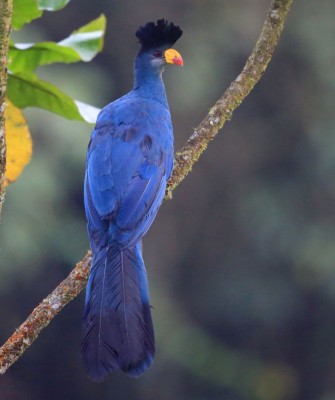
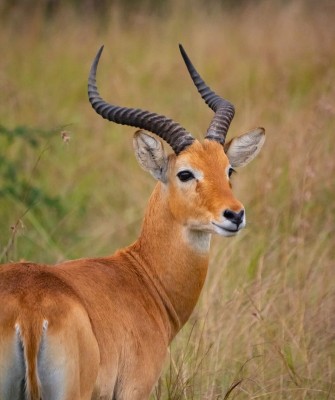
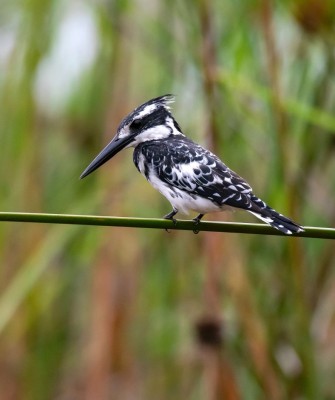
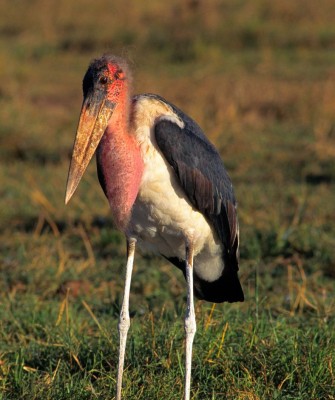
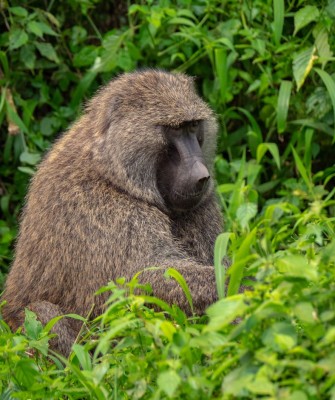
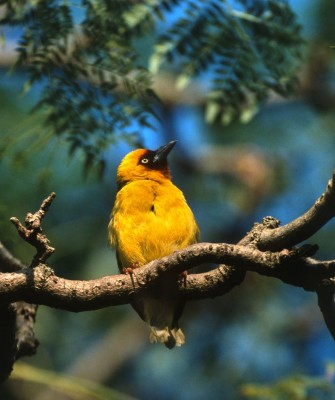
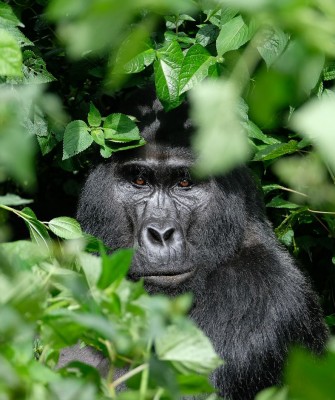
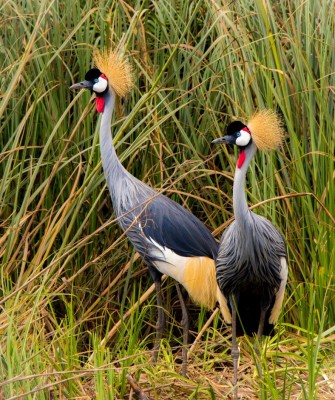








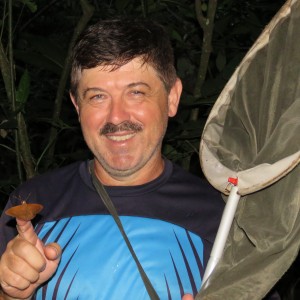
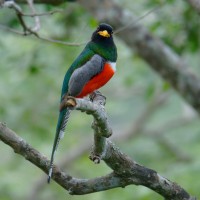 Arizona Monsoon Madness Birding & Nature in a Season of Wonder!August 11 - 18, 2024
Arizona Monsoon Madness Birding & Nature in a Season of Wonder!August 11 - 18, 2024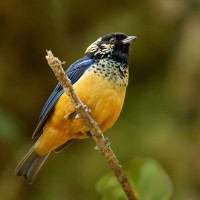 Western Panama: Tranquilo BayOctober 14 - 21, 2024, w/Mt. Totumas extension
Western Panama: Tranquilo BayOctober 14 - 21, 2024, w/Mt. Totumas extension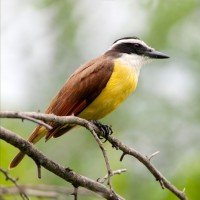 South Texas Birding & Nature Special Departure!November 11 - 19, 2024
South Texas Birding & Nature Special Departure!November 11 - 19, 2024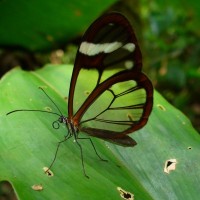 Honduras Butterfly FestivalJanuary 7 - 12, 2025
Honduras Butterfly FestivalJanuary 7 - 12, 2025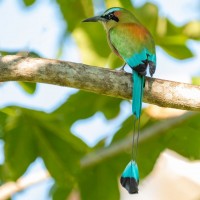 Honduras: Stellar Birding & Maya RuinsFebruary 2 - 10, 2025
Honduras: Stellar Birding & Maya RuinsFebruary 2 - 10, 2025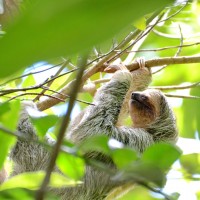 Panama: Birds & MammalsFebruary 28 - March 8, 2025
Panama: Birds & MammalsFebruary 28 - March 8, 2025







